


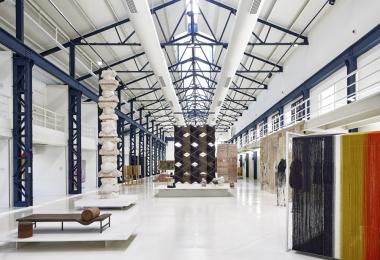
The Hangar exhibition of Amman Design Week 2019 took place at the old electricity Hangar in Ras El Ain and was curated by Noura Al Sayeh-Holtrop. The exhibition showcased diverse work by local and regional designers from across disciplines; architecture, product, fashion, furniture, and graphic design.
Photo by Edmund Sumner
© Amman Design Week 2019
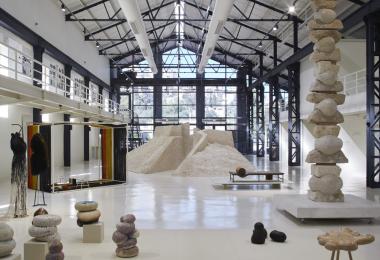
The Hangar exhibition of Amman Design Week 2019 took place at the old electricity Hangar in Ras El Ain and was curated by Noura Al Sayeh-Holtrop. The exhibition showcased diverse work by local and regional designers from across disciplines; architecture, product, fashion, furniture, and graphic design.
Photo by Edmund Sumner
© Amman Design Week 2019
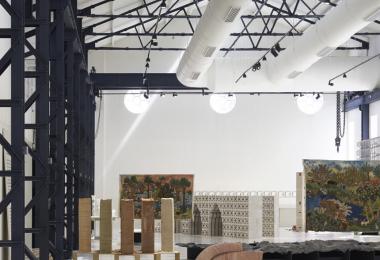
The Hangar exhibition of Amman Design Week 2019 took place at the old electricity Hangar in Ras El Ain and was curated by Noura Al Sayeh-Holtrop. The exhibition showcased diverse work by local and regional designers from across disciplines; architecture, product, fashion, furniture, and graphic design.
Photo by Edmund Sumner
© Amman Design Week 2019
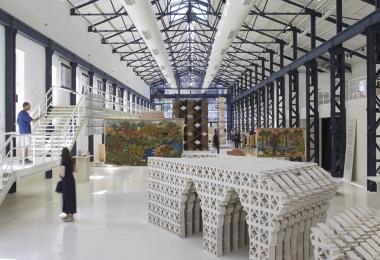
The Hangar exhibition of Amman Design Week 2019 took place at the old electricity Hangar in Ras El Ain and was curated by Noura Al Sayeh-Holtrop. The exhibition showcased diverse work by local and regional designers from across disciplines; architecture, product, fashion, furniture, and graphic design.
Photo by Edmund Sumner
© Amman Design Week 2019
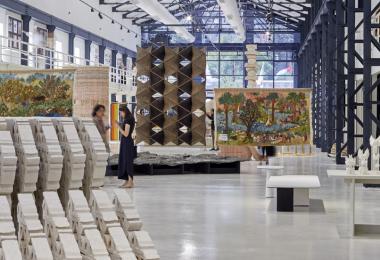
The Hangar exhibition of Amman Design Week 2019 took place at the old electricity Hangar in Ras El Ain and was curated by Noura Al Sayeh-Holtrop. The exhibition showcased diverse work by local and regional designers from across disciplines; architecture, product, fashion, furniture, and graphic design.
Photo by Edmund Sumner
© Amman Design Week 2019
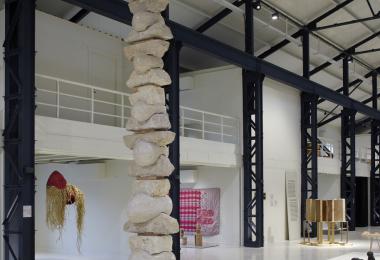
The stone column is made out of collected stone architectural ruins. The different stone elements come from different periods of time and illustrate different techniques of construction. The stones were geometrically analyzed and through stereotomy research, interfaces between the stone elements were created in order to build a self-standing column.
The research focuses on the re-use of stone elements and their adaptation to new forms and configurations, as structural elements of architecture. It addresses the question of the possibilities of reusing stone as a structural material as well as the finite resource that it embodies and its consequent effect on the natural landscape. It opens up the possibility of integrating salvaged building components in contemporary architecture.
Photo by Edmund Sumner
© Amman Design Week 2019
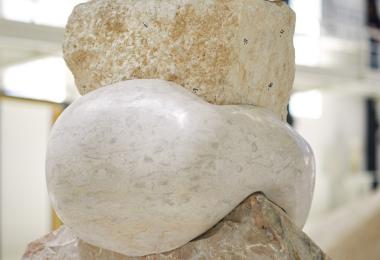
The stone column is made out of collected stone architectural ruins. The different stone elements come from different periods of time and illustrate different techniques of construction. The stones were geometrically analyzed and through stereotomy research, interfaces between the stone elements were created in order to build a self-standing column.
The research focuses on the re-use of stone elements and their adaptation to new forms and configurations, as structural elements of architecture. It addresses the question of the possibilities of reusing stone as a structural material as well as the finite resource that it embodies and its consequent effect on the natural landscape. It opens up the possibility of integrating salvaged building components in contemporary architecture.
Photo by Edmund Sumner
© Amman Design Week 2019
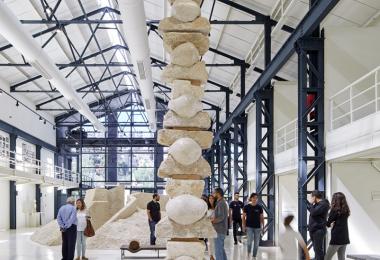
The stone column is made out of collected stone architectural ruins. The different stone elements come from different periods of time and illustrate different techniques of construction. The stones were geometrically analyzed and through stereotomy research, interfaces between the stone elements were created in order to build a self-standing column.
The research focuses on the re-use of stone elements and their adaptation to new forms and configurations, as structural elements of architecture. It addresses the question of the possibilities of reusing stone as a structural material as well as the finite resource that it embodies and its consequent effect on the natural landscape. It opens up the possibility of integrating salvaged building components in contemporary architecture.
Photo by Edmund Sumner
© Amman Design Week 2019
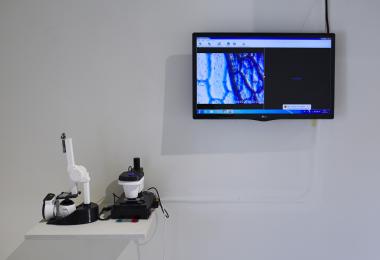
In schools in low-resource settings, learning about basic cell structure can be a challenge due to the lack of resources. This product is a low-cost microscope enabling children, and possibly university students, to further learn about small organisms in an easy manner.
The microscope is built from low-cost material and can be operated using ultraviolet, infrared, and visible light. There are three ports to the microscope which allows the microscope to be connected to a laptop or a smartphone so that teachers and professors can project and share images with large audience. The magnification power can reach more than 800x which makes it suitable to observe various types of cells, chromosomes, and paramecium that are found in shallow waters. In addition to being an educational tool, this microscope can also be used for autopsies.
This work was supported by ONExUNICEF program (UNICEF Jordan and the One Foundation).
© Amman Design Week 2019
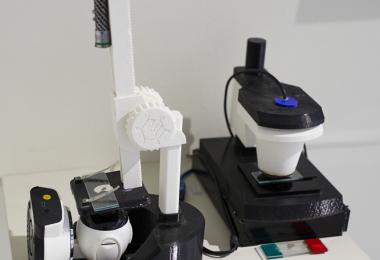
In schools in low-resource settings, learning about basic cell structure can be a challenge due to the lack of resources. This product is a low-cost microscope enabling children, and possibly university students, to further learn about small organisms in an easy manner.
The microscope is built from low-cost material and can be operated using ultraviolet, infrared, and visible light. There are three ports to the microscope which allows the microscope to be connected to a laptop or a smartphone so that teachers and professors can project and share images with large audience. The magnification power can reach more than 800x which makes it suitable to observe various types of cells, chromosomes, and paramecium that are found in shallow waters. In addition to being an educational tool, this microscope can also be used for autopsies.
This work was supported by ONExUNICEF program (UNICEF Jordan and the One Foundation).
© Amman Design Week 2019

In schools in low-resource settings, learning about basic cell structure can be a challenge due to the lack of resources. This product is a low-cost microscope enabling children, and possibly university students, to further learn about small organisms in an easy manner.
The microscope is built from low-cost material and can be operated using ultraviolet, infrared, and visible light. There are three ports to the microscope which allows the microscope to be connected to a laptop or a smartphone so that teachers and professors can project and share images with large audience. The magnification power can reach more than 800x which makes it suitable to observe various types of cells, chromosomes, and paramecium that are found in shallow waters. In addition to being an educational tool, this microscope can also be used for autopsies.
This work was supported by ONExUNICEF program (UNICEF Jordan and the One Foundation).
© Amman Design Week 2019
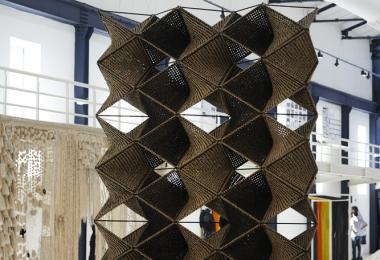
Meeting Points is a working prototype for a reconfigurable composite material system, a tensility and equilibrium of steel, wood, and fiber only made possible through each individual connection and the intuitive hands that created them. These different meeting points - between fiber and structure, material and space - arise in response to the design processes of Bedouin tent-making craft; communal practices of weaving and construction traditionally tasked to the Women of the tribe, the invisible architects in a patriarchal system.
Meeting points is a porous self-structuring tapestry, at both the scale of its dynamic lattice structure and the pliable hand-knitted geometric pattern which lends the material system its mechanical properties. Evolving through collaboration, it is another meeting point: one between designer and community. One which seeks to sustain the legacies of traditional design processes, passed down from generation to generation, within the contemporary and future canons of design knowledge in Jordan.
© Amman Design Week 2019

Meeting Points is a working prototype for a reconfigurable composite material system, a tensility and equilibrium of steel, wood, and fiber only made possible through each individual connection and the intuitive hands that created them. These different meeting points - between fiber and structure, material and space - arise in response to the design processes of Bedouin tent-making craft; communal practices of weaving and construction traditionally tasked to the Women of the tribe, the invisible architects in a patriarchal system.
Meeting points is a porous self-structuring tapestry, at both the scale of its dynamic lattice structure and the pliable hand-knitted geometric pattern which lends the material system its mechanical properties. Evolving through collaboration, it is another meeting point: one between designer and community. One which seeks to sustain the legacies of traditional design processes, passed down from generation to generation, within the contemporary and future canons of design knowledge in Jordan.
© Amman Design Week 2019
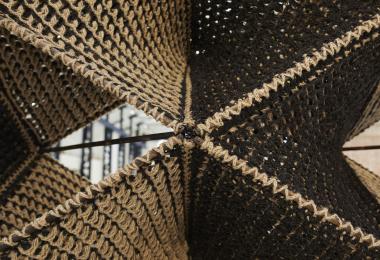
Meeting Points is a working prototype for a reconfigurable composite material system, a tensility and equilibrium of steel, wood, and fiber only made possible through each individual connection and the intuitive hands that created them. These different meeting points - between fiber and structure, material and space - arise in response to the design processes of Bedouin tent-making craft; communal practices of weaving and construction traditionally tasked to the Women of the tribe, the invisible architects in a patriarchal system.
Meeting points is a porous self-structuring tapestry, at both the scale of its dynamic lattice structure and the pliable hand-knitted geometric pattern which lends the material system its mechanical properties. Evolving through collaboration, it is another meeting point: one between designer and community. One which seeks to sustain the legacies of traditional design processes, passed down from generation to generation, within the contemporary and future canons of design knowledge in Jordan.
© Amman Design Week 2019

Through the use of pep, the designers hope to reawaken the pure joy of repetitive rocking or swaying – the comforting feelings we have all experienced in our lives, whether in the arms of our caregivers or on the famous rocking horse toy.
© Amman Design Week 2019
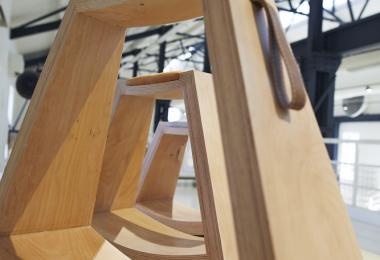
Through the use of pep, the designers hope to reawaken the pure joy of repetitive rocking or swaying – the comforting feelings we have all experienced in our lives, whether in the arms of our caregivers or on the famous rocking horse toy.
© Amman Design Week 2019

By using a combination of conductive and resistive threads, Silence Tapestry changes color as people interact with it.
The threads are connected by a yarn-dyed with thermochromic ink. When a person touches the soft sensor, a current passes through the created mesh, generating heat and causing the yarn to change color.
© Amman Design Week 2019
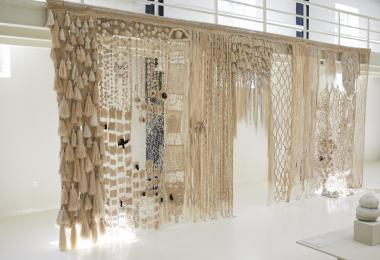
Executed in a collaboration between Amina Agueznay and 23 craftswomen (maalmates) from the Entraide nationale of Bouznika, a small town near Casablanca, Morocco, Skin is an 18-square-meter patchwork made in the natural tones of recycled fishnet, cotton and sabra thread (vegetal viscose).
Created in reference to traditional Moroccan arts and crafts during a two-week long workshop, this piece calls on the transmission of ancestral know-hows and vernacular techniques used for clothing, home decoration, furnishing, and ornamental trimmings, and others.
Skin also attempts to tell the story of these women who spend their time working in the secluded environment of their own home where they are by tradition kept hidden. Extensions of those passed down over the centuries from mother to daughter, the gestures they perform daily structure the life and work of each of them and constitute the backdrop of Skin. Throughout this collective work, their individuality, singularity and sensitivity randomly graft to one another, just as many scraps of skin, to form some sort of feminine scar tissue, sensorial and sensual, that reinterprets freely a cultural heritage and reinvents the traditional Moroccan patterns.
© Amman Design Week 2019
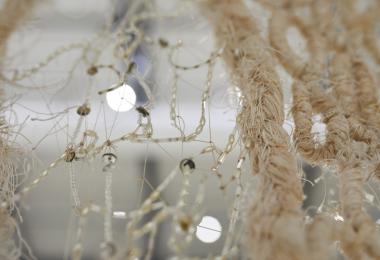
Executed in a collaboration between Amina Agueznay and 23 craftswomen (maalmates) from the Entraide nationale of Bouznika, a small town near Casablanca, Morocco, Skin is an 18-square-meter patchwork made in the natural tones of recycled fishnet, cotton and sabra thread (vegetal viscose).
Created in reference to traditional Moroccan arts and crafts during a two-week long workshop, this piece calls on the transmission of ancestral know-hows and vernacular techniques used for clothing, home decoration, furnishing, and ornamental trimmings, and others.
Skin also attempts to tell the story of these women who spend their time working in the secluded environment of their own home where they are by tradition kept hidden. Extensions of those passed down over the centuries from mother to daughter, the gestures they perform daily structure the life and work of each of them and constitute the backdrop of Skin. Throughout this collective work, their individuality, singularity and sensitivity randomly graft to one another, just as many scraps of skin, to form some sort of feminine scar tissue, sensorial and sensual, that reinterprets freely a cultural heritage and reinvents the traditional Moroccan patterns.
© Amman Design Week 2019
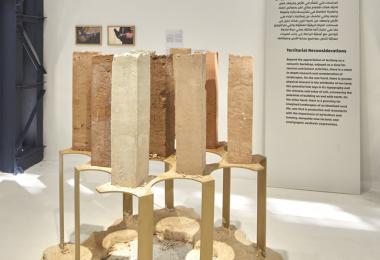
This work is designed to last for the duration of the exhibition. Nine columns, each composed of soils found in different parts of Jordan, are placed on a platform. Each column is constructed using a rammed earth building technique and is set in stratified layers, reflecting a distinct color and texture.
Visitors are invited to touch these geometric forms and as they do, they crumble and erode. The platform acts as a sieve, allowing crumble and debris from the mud columns to fall through it onto the floor below.
Photo by Edmund Sumner
© Amman Design Week 2019
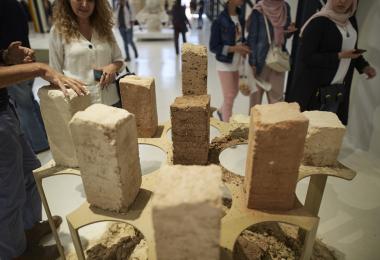
This work is designed to last for the duration of the exhibition. Nine columns, each composed of soils found in different parts of Jordan, are placed on a platform. Each column is constructed using a rammed earth building technique and is set in stratified layers, reflecting a distinct color and texture.
Visitors are invited to touch these geometric forms and as they do, they crumble and erode. The platform acts as a sieve, allowing crumble and debris from the mud columns to fall through it onto the floor below.
© Amman Design Week 2019
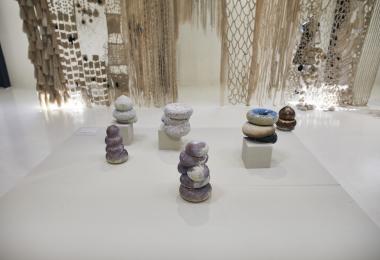
The exhibited collection is inspired by naturally shaped pebbles forming harmony and equilibrium with their surroundings. Combined with color and texture, the pieces explore the tension of opposites; an interplay between modernism through candy-like colors and the representation of harsh metals and rough earth-like eruptions.
© Amman Design Week 2019
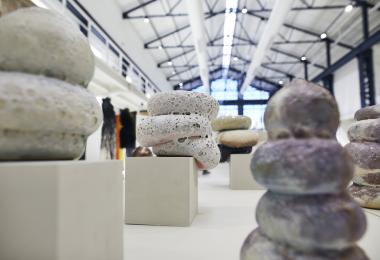
The exhibited collection is inspired by naturally shaped pebbles forming harmony and equilibrium with their surroundings. Combined with color and texture, the pieces explore the tension of opposites; an interplay between modernism through candy-like colors and the representation of harsh metals and rough earth-like eruptions.
© Amman Design Week 2019
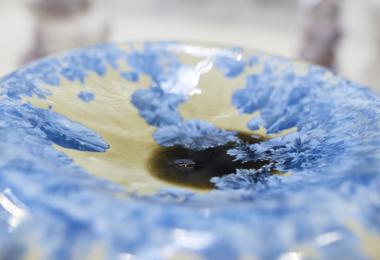
The exhibited collection is inspired by naturally shaped pebbles forming harmony and equilibrium with their surroundings. Combined with color and texture, the pieces explore the tension of opposites; an interplay between modernism through candy-like colors and the representation of harsh metals and rough earth-like eruptions.
© Amman Design Week 2019

Models, furniture and useful objects are placed next to, on top of, or behind one another. Together, all artifacts, all architecture, present themselves as a sort of still life; a place in between a city and a living room. Trying to determine the scale of the artifact and what it pretends to be, one would ask is it a model? Furniture? Or architecture?
Model because when scaled up what we expect it to be becomes real. Architecture because the relationship to the space it makes, or influences, is real. It has a real plan and a real section and it makes an intriguing space. Furniture because of its real size. You can place things on it and sit on it and it becomes a chair. Or you can divide a room and obstruct a view with it and it becomes a screen.
© Amman Design Week 2019
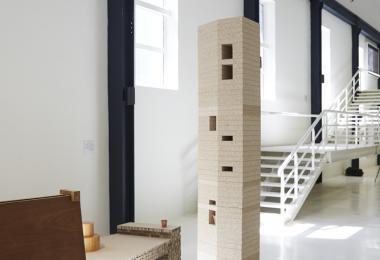
Models, furniture and useful objects are placed next to, on top of, or behind one another. Together, all artifacts, all architecture, present themselves as a sort of still life; a place in between a city and a living room. Trying to determine the scale of the artifact and what it pretends to be, one would ask is it a model? Furniture? Or architecture?
Model because when scaled up what we expect it to be becomes real. Architecture because the relationship to the space it makes, or influences, is real. It has a real plan and a real section and it makes an intriguing space. Furniture because of its real size. You can place things on it and sit on it and it becomes a chair. Or you can divide a room and obstruct a view with it and it becomes a screen.
© Amman Design Week 2019

It is estimated that around 11,500,000 disposable argeileh pipes are used only once and thrown out every year in Jordan alone. This amounts to roughly 430,000,000 in the Arab World annually.
The Argeileh Project is a systems-based approach to addressing this huge environmental problem. Proposed in two parts; the project shows how we can at first re-purpose the plastic waste that the current system has created into functional everyday objects, while also proposing a circular production and consumption system to significantly reduce the environmental impact of the disposable argeileh pipes.
This work is a house brick made of recycled argeileh pipes, made by PLORO group.
© Amman Design Week 2019

It is estimated that around 11,500,000 disposable argeileh pipes are used only once and thrown out every year in Jordan alone. This amounts to roughly 430,000,000 in the Arab World annually.
The Argeileh Project is a systems-based approach to addressing this huge environmental problem. Proposed in two parts; the project shows how we can at first re-purpose the plastic waste that the current system has created into functional everyday objects, while also proposing a circular production and consumption system to significantly reduce the environmental impact of the disposable argeileh pipes.
© Amman Design Week 2019
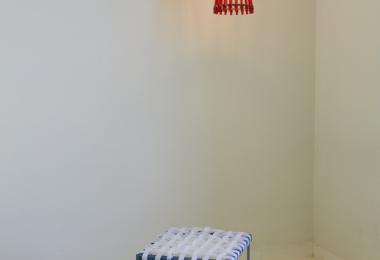
It is estimated that around 11,500,000 disposable argeileh pipes are used only once and thrown out every year in Jordan alone. This amounts to roughly 430,000,000 in the Arab World annually.
The Argeileh Project is a systems-based approach to addressing this huge environmental problem. Proposed in two parts; the project shows how we can at first re-purpose the plastic waste that the current system has created into functional everyday objects, while also proposing a circular production and consumption system to significantly reduce the environmental impact of the disposable argeileh pipes.
TAP Lighting and TAP stool are designed by Bassam Huneidi.
© Amman Design Week 2019
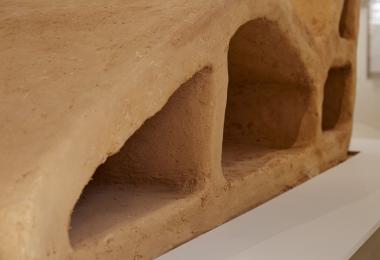
Earth Chair attempts to tackle two issues in Jordan: the excessive use of concrete as a construction material, and the lack of reading.
Concrete remains the most heavily used construction material in Jordan, although the use of local natural materials and ancient technologies would create more suitable spaces for dwelling in this arid climate. The chair addresses the issue of self-colonization and loss of the Arab desert vernacular along with its associated crafts.
Furthermore, the ergonomic quality of the chair is designed to encourage reading.
© Amman Design Week 2019.

Earth Chair attempts to tackle two issues in Jordan: the excessive use of concrete as a construction material, and the lack of reading.
Concrete remains the most heavily used construction material in Jordan, although the use of local natural materials and ancient technologies would create more suitable spaces for dwelling in this arid climate. The chair addresses the issue of self-colonization and loss of the Arab desert vernacular along with its associated crafts.
Furthermore, the ergonomic quality of the chair is designed to encourage reading.
© Amman Design Week 2019

'Minor Paradises' is a prototype for a waterless public garden.
The Arabic-speaking countries of the eastern Mediterranean refer to a garden as jnaina or 'little paradise'. This diminutive form of jana in Semitic languages is used interchangeably for both garden and for heaven. The jnaina, a delicate curation of plants in an ordered composition, is a fulfillment of heaven in miniature. It is an ordered personal realm, a small piece of a larger ecological aspiration to see a world as a continuous field of organized life.
With the advent of the modern state many of these aspirations aligned with a colonial vision for a verdant Middle East. Much of the Arabian landscape in the Levant and the Gulf is an inherited fantasy: the well mowed lawn, the verdant setback – notions of care and fecundity that are only made possible by the availability of desalinated and treated water.
In Jordan the questions of landscape and developmental aspirations are interlinked, they both ask how paradise can be re-imagined in one of the world's most water scarce countries.
It is in this context that for Amman Design Week, Civil Architecture and studiolibani present a prototype for a waterless public garden: a provocation set against both the Arab ideal of the garden as heaven and against colonial notions of modern landscape. The waterless gardens also feature water resilient plant life from across the Jordanian landscape creating a sampling of the Levantine ecosystem. The installation, titled: 'Minor Paradises', asks how the public garden can be used as a way to rethink scarcity.
Photo by Edmund Sumner
© Amman Design Week 2019
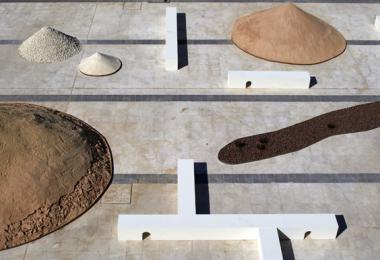
'Minor Paradises' is a prototype for a waterless public garden.
The Arabic-speaking countries of the eastern Mediterranean refer to a garden as jnaina or 'little paradise'. This diminutive form of jana in Semitic languages is used interchangeably for both garden and for heaven. The jnaina, a delicate curation of plants in an ordered composition, is a fulfillment of heaven in miniature. It is an ordered personal realm, a small piece of a larger ecological aspiration to see a world as a continuous field of organized life.
With the advent of the modern state many of these aspirations aligned with a colonial vision for a verdant Middle East. Much of the Arabian landscape in the Levant and the Gulf is an inherited fantasy: the well mowed lawn, the verdant setback – notions of care and fecundity that are only made possible by the availability of desalinated and treated water.
In Jordan the questions of landscape and developmental aspirations are interlinked, they both ask how paradise can be re-imagined in one of the world's most water scarce countries.
It is in this context that for Amman Design Week, Civil Architecture and studiolibani present a prototype for a waterless public garden: a provocation set against both the Arab ideal of the garden as heaven and against colonial notions of modern landscape. The waterless gardens also feature water resilient plant life from across the Jordanian landscape creating a sampling of the Levantine ecosystem. The installation, titled: 'Minor Paradises', asks how the public garden can be used as a way to rethink scarcity.
Photo by Edmund Sumner
© Amman Design Week 2019
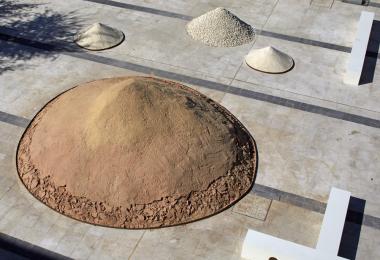
'Minor Paradises' is a prototype for a waterless public garden.
The Arabic-speaking countries of the eastern Mediterranean refer to a garden as jnaina or 'little paradise'. This diminutive form of jana in Semitic languages is used interchangeably for both garden and for heaven. The jnaina, a delicate curation of plants in an ordered composition, is a fulfillment of heaven in miniature. It is an ordered personal realm, a small piece of a larger ecological aspiration to see a world as a continuous field of organized life.
With the advent of the modern state many of these aspirations aligned with a colonial vision for a verdant Middle East. Much of the Arabian landscape in the Levant and the Gulf is an inherited fantasy: the well mowed lawn, the verdant setback – notions of care and fecundity that are only made possible by the availability of desalinated and treated water.
In Jordan the questions of landscape and developmental aspirations are interlinked, they both ask how paradise can be re-imagined in one of the world's most water scarce countries.
It is in this context that for Amman Design Week, Civil Architecture and studiolibani present a prototype for a waterless public garden: a provocation set against both the Arab ideal of the garden as heaven and against colonial notions of modern landscape. The waterless gardens also feature water resilient plant life from across the Jordanian landscape creating a sampling of the Levantine ecosystem. The installation, titled: 'Minor Paradises', asks how the public garden can be used as a way to rethink scarcity.
Photo by Edmund Sumner
© Amman Design Week 2019
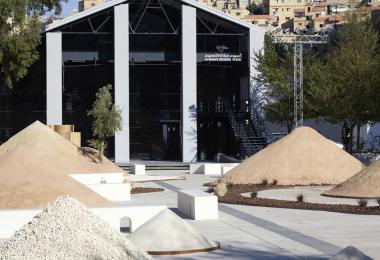
'Minor Paradises' is a prototype for a waterless public garden.
The Arabic-speaking countries of the eastern Mediterranean refer to a garden as jnaina or 'little paradise'. This diminutive form of jana in Semitic languages is used interchangeably for both garden and for heaven. The jnaina, a delicate curation of plants in an ordered composition, is a fulfillment of heaven in miniature. It is an ordered personal realm, a small piece of a larger ecological aspiration to see a world as a continuous field of organized life.
With the advent of the modern state many of these aspirations aligned with a colonial vision for a verdant Middle East. Much of the Arabian landscape in the Levant and the Gulf is an inherited fantasy: the well mowed lawn, the verdant setback – notions of care and fecundity that are only made possible by the availability of desalinated and treated water.
In Jordan the questions of landscape and developmental aspirations are interlinked, they both ask how paradise can be re-imagined in one of the world's most water scarce countries.
It is in this context that for Amman Design Week, Civil Architecture and studiolibani present a prototype for a waterless public garden: a provocation set against both the Arab ideal of the garden as heaven and against colonial notions of modern landscape. The waterless gardens also feature water resilient plant life from across the Jordanian landscape creating a sampling of the Levantine ecosystem. The installation, titled: 'Minor Paradises', asks how the public garden can be used as a way to rethink scarcity.
Photo by Edmund Sumner
© Amman Design Week 2019
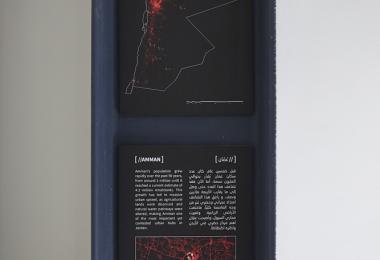
"Urban Patterns" is a visual cartographic exhibition which highlights the effects of human exploitation of natural landscapes in Jordan.
For millennia, complex ecologies have dwelled in harmony with the local inhabitants of the region, in sustainable give-and-take cycles. However, in the shadow of pressuring global economics, rapid population growth, destabilized regional geopolitics and high demand on natural resources, the face of Jordan's landscapes is drastically being altered in the process. These massive impacts are primarily caused by unregulated urban sprawl, the broad and expansive mining industry, the systematic occupation of forest and agricultural regions, and the overconsumption of natural water resources.
Covering an area of 89,000 km², the bounding region encapsulating Jordan was fully mapped narrowing almost 2500 points of interest via Graphic information systems, satellite imagery, geological cartographic maps, and comparative analysis of declassified CIA satellite imagery of the region from the ‘60s.
© Amman Design Week 2019

"Urban Patterns" is a visual cartographic exhibition which highlights the effects of human exploitation of natural landscapes in Jordan.
For millennia, complex ecologies have dwelled in harmony with the local inhabitants of the region, in sustainable give-and-take cycles. However, in the shadow of pressuring global economics, rapid population growth, destabilized regional geopolitics and high demand on natural resources, the face of Jordan's landscapes is drastically being altered in the process. These massive impacts are primarily caused by unregulated urban sprawl, the broad and expansive mining industry, the systematic occupation of forest and agricultural regions, and the overconsumption of natural water resources.
Covering an area of 89,000 km², the bounding region encapsulating Jordan was fully mapped narrowing almost 2500 points of interest via Graphic information systems, satellite imagery, geological cartographic maps, and comparative analysis of declassified CIA satellite imagery of the region from the ‘60s.
© Amman Design Week 2019
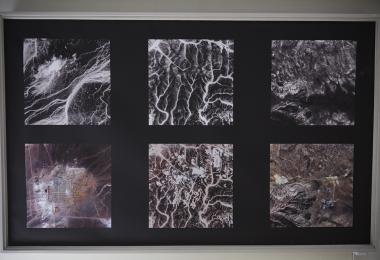
"Urban Patterns" is a visual cartographic exhibition which highlights the effects of human exploitation of natural landscapes in Jordan.
For millennia, complex ecologies have dwelled in harmony with the local inhabitants of the region, in sustainable give-and-take cycles. However, in the shadow of pressuring global economics, rapid population growth, destabilized regional geopolitics and high demand on natural resources, the face of Jordan's landscapes is drastically being altered in the process. These massive impacts are primarily caused by unregulated urban sprawl, the broad and expansive mining industry, the systematic occupation of forest and agricultural regions, and the overconsumption of natural water resources.
Covering an area of 89,000 km², the bounding region encapsulating Jordan was fully mapped narrowing almost 2500 points of interest via Graphic information systems, satellite imagery, geological cartographic maps, and comparative analysis of declassified CIA satellite imagery of the region from the ‘60s.
© Amman Design Week 2019
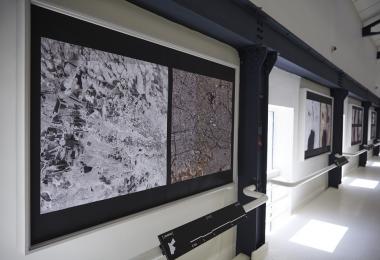
"Urban Patterns" is a visual cartographic exhibition which highlights the effects of human exploitation of natural landscapes in Jordan.
For millennia, complex ecologies have dwelled in harmony with the local inhabitants of the region, in sustainable give-and-take cycles. However, in the shadow of pressuring global economics, rapid population growth, destabilized regional geopolitics and high demand on natural resources, the face of Jordan's landscapes is drastically being altered in the process. These massive impacts are primarily caused by unregulated urban sprawl, the broad and expansive mining industry, the systematic occupation of forest and agricultural regions, and the overconsumption of natural water resources.
Covering an area of 89,000 km², the bounding region encapsulating Jordan was fully mapped narrowing almost 2500 points of interest via Graphic information systems, satellite imagery, geological cartographic maps, and comparative analysis of declassified CIA satellite imagery of the region from the ‘60s.
© Amman Design Week 2019
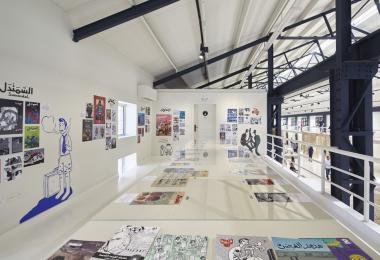
An exploration of the comics in the Arab world.
Photo by Edmund Sumner
© Amman Design Week 2019
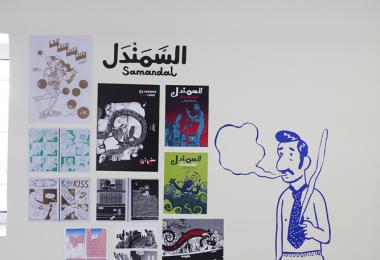
Samandal is a volunteer-based non-profit organization dedicated to the advancement of the art of comics in Lebanon and the rest of the world, publishing and organizing comics-related events since 2007.
© Amman Design Week 2019
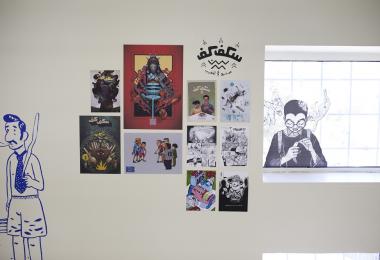
Skefkef is a Casablanca-based independent comics magazine.
© Amman Design Week 2019

Garage is an Egyptian independent magazine for comic narrative that stemmed out of the ‘Planet of Painters’ project. It was founded by the duo Twins Cartoon. The magazine merges between work by professional and young artists from all over the Arab world with the goal of promoting interaction between artists and creating new comics, in the hopes of making comics as a pop art.
© Amman Design Week 2019

Skefkef aims to explore the social and cultural dimensions of Morocco through drawings and texts that oscillate between serious and satirical, good and bad, white and black, while describing the nuances and the contrasts of a changing society.
© Amman Design Week 2019
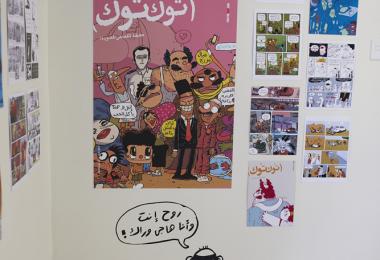
TokTok is a review that aims to produce a bustling mass of comic strips in a free, contemporary spirit, drawn and edited by its own artists. It was founded by artists Shennawy, Makhlouf, Andeel, Hicham Rahma, and Tawfik.
© Amman Design Week 2019
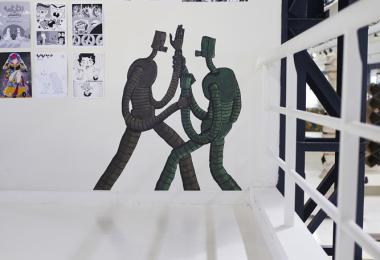
Fanzeen is a comics collective launched in 2018 in Amman, Jordan. Mike V. Derderian, the publisher and editor, wants to produce comics that tackle everything from science fiction to fantasy, with comic artists, illustrators and writers from this region and abroad.
© Amman Design Week 2019
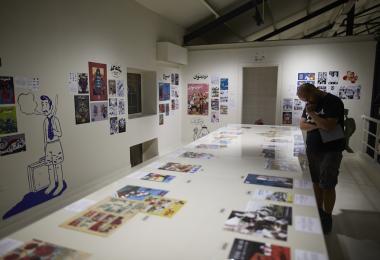
© Amman Design Week 2019

Street vendors are an ever-present phenomenon in the urban environment of Amman, whose tangible social and economic implications are reflected in their complex legal and commercial standing. In recent years, their presence has been contested despite the potential of them becoming integrated and independent micro-business owners.
The project’s ambition, in creating this flexible, multi-use, and affordable street trolley is to help street vendors and any other potential beneficiaries in organizing their business in the most space-effective manner, while providing them with greater mobility. It takes into consideration the big number of informal street vendors and workers throughout Jordan and the Arab World, and attempts to develop and improve on the mobile support they require to navigate the streets.
© Amman Design Week 2019
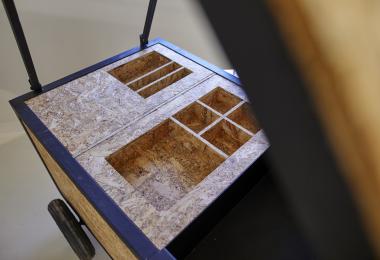
Street vendors are an ever-present phenomenon in the urban environment of Amman, whose tangible social and economic implications are reflected in their complex legal and commercial standing. In recent years, their presence has been contested despite the potential of them becoming integrated and independent micro-business owners.
The project’s ambition, in creating this flexible, multi-use, and affordable street trolley is to help street vendors and any other potential beneficiaries in organizing their business in the most space-effective manner, while providing them with greater mobility. It takes into consideration the big number of informal street vendors and workers throughout Jordan and the Arab World, and attempts to develop and improve on the mobile support they require to navigate the streets.
© Amman Design Week 2019
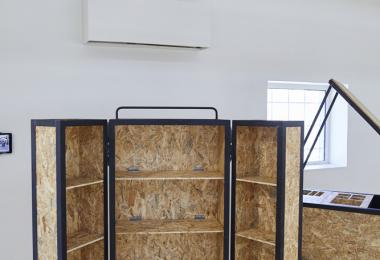
Street vendors are an ever-present phenomenon in the urban environment of Amman, whose tangible social and economic implications are reflected in their complex legal and commercial standing. In recent years, their presence has been contested despite the potential of them becoming integrated and independent micro-business owners.
The project’s ambition, in creating this flexible, multi-use, and affordable street trolley is to help street vendors and any other potential beneficiaries in organizing their business in the most space-effective manner, while providing them with greater mobility. It takes into consideration the big number of informal street vendors and workers throughout Jordan and the Arab World, and attempts to develop and improve on the mobile support they require to navigate the streets.
© Amman Design Week 2019
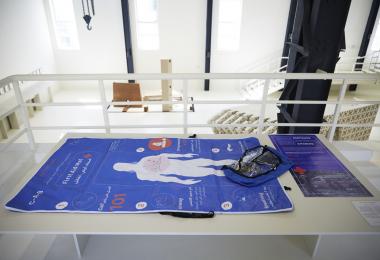
Access to emergency care remains a challenge in certain countries. Contrary to the recommended 8-minute response time in most communities around the world, in Palestine, an ambulance can be stopped at every checkpoint, with an average delay of 15 minutes, excluding the time an ambulance spends in traffic leading up to the checkpoints. Furthermore, it can take 90 minutes or more to coordinate the ambulance trip with Israeli authorities requesting a transfer to hospitals in Jerusalem, in case a patient requires additional treatment not available in their area.
The project presents a functional design alternative to using the first aid toolkit, that helps facilitate personal medical care during emergency management efforts, in case of a paramedic delay or the need for instant treatment. One of the project goals is the implementation of an emergency ready pre-hospital system that engages ordinary citizens in first aid.
© Amman Design Week 2019
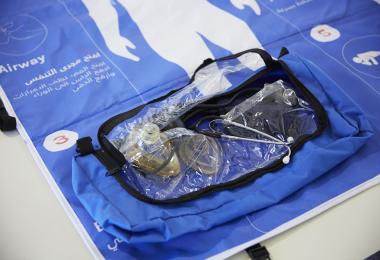
Access to emergency care remains a challenge in certain countries. Contrary to the recommended 8-minute response time in most communities around the world, in Palestine, an ambulance can be stopped at every checkpoint, with an average delay of 15 minutes, excluding the time an ambulance spends in traffic leading up to the checkpoints. Furthermore, it can take 90 minutes or more to coordinate the ambulance trip with Israeli authorities requesting a transfer to hospitals in Jerusalem, in case a patient requires additional treatment not available in their area.
The project presents a functional design alternative to using the first aid toolkit, that helps facilitate personal medical care during emergency management efforts, in case of a paramedic delay or the need for instant treatment. One of the project goals is the implementation of an emergency ready pre-hospital system that engages ordinary citizens in first aid.
© Amman Design Week 2019

Access to emergency care remains a challenge in certain countries. Contrary to the recommended 8-minute response time in most communities around the world, in Palestine, an ambulance can be stopped at every checkpoint, with an average delay of 15 minutes, excluding the time an ambulance spends in traffic leading up to the checkpoints. Furthermore, it can take 90 minutes or more to coordinate the ambulance trip with Israeli authorities requesting a transfer to hospitals in Jerusalem, in case a patient requires additional treatment not available in their area.
The project presents a functional design alternative to using the first aid toolkit, that helps facilitate personal medical care during emergency management efforts, in case of a paramedic delay or the need for instant treatment. One of the project goals is the implementation of an emergency ready pre-hospital system that engages ordinary citizens in first aid.
© Amman Design Week 2019
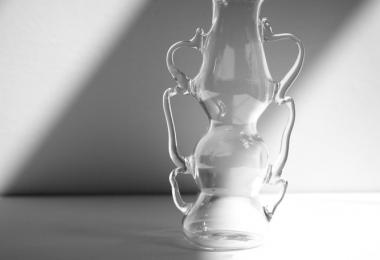
The collection presented which is part of the ongoing work ‘Hollow Forms,’ echoes and replicates the forms of actual vessels from the Levant currently held by the Metropolitan Museum of Art in New York, and takes their stories a step further by allowing the objects to “speak.”
The project sheds light on archaeological glass artifacts from the Levant that have been displaced and are currently displayed behind glass vitrines and storage boxes in western institutions. These vessels are seen as deeply critical forms in the construct of the global south's imaginary but are inaccessible to the region's audience as their stories are told by authorities with a different perspective. The display renders the vessels invisible, as they are in their current state, yet plays with the shadows of those forms to assert the mark they make on the ground. The vessels exhibited here were blown to life by the Twam family in Jaba’, Palestine.
© Amman Design Week 2019
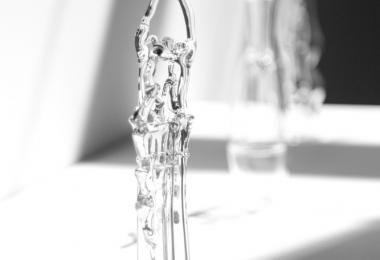
The collection presented which is part of the ongoing work ‘Hollow Forms,’ echoes and replicates the forms of actual vessels from the Levant currently held by the Metropolitan Museum of Art in New York, and takes their stories a step further by allowing the objects to “speak.”
The project sheds light on archaeological glass artifacts from the Levant that have been displaced and are currently displayed behind glass vitrines and storage boxes in western institutions. These vessels are seen as deeply critical forms in the construct of the global south's imaginary but are inaccessible to the region's audience as their stories are told by authorities with a different perspective. The display renders the vessels invisible, as they are in their current state, yet plays with the shadows of those forms to assert the mark they make on the ground. The vessels exhibited here were blown to life by the Twam family in Jaba’, Palestine.
© Amman Design Week 2019
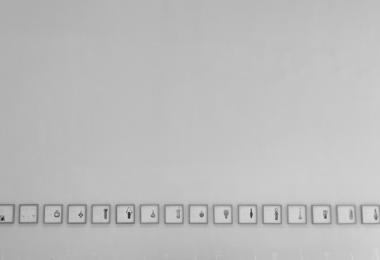
The collection presented which is part of the ongoing work ‘Hollow Forms,’ echoes and replicates the forms of actual vessels from the Levant currently held by the Metropolitan Museum of Art in New York, and takes their stories a step further by allowing the objects to “speak.”
The project sheds light on archaeological glass artifacts from the Levant that have been displaced and are currently displayed behind glass vitrines and storage boxes in western institutions. These vessels are seen as deeply critical forms in the construct of the global south's imaginary but are inaccessible to the region's audience as their stories are told by authorities with a different perspective. The display renders the vessels invisible, as they are in their current state, yet plays with the shadows of those forms to assert the mark they make on the ground. The vessels exhibited here were blown to life by the Twam family in Jaba’, Palestine.
© Amman Design Week 2019
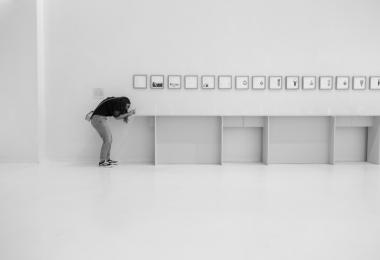
The collection presented which is part of the ongoing work ‘Hollow Forms,’ echoes and replicates the forms of actual vessels from the Levant currently held by the Metropolitan Museum of Art in New York, and takes their stories a step further by allowing the objects to “speak.”
The project sheds light on archaeological glass artifacts from the Levant that have been displaced and are currently displayed behind glass vitrines and storage boxes in western institutions. These vessels are seen as deeply critical forms in the construct of the global south's imaginary but are inaccessible to the region's audience as their stories are told by authorities with a different perspective. The display renders the vessels invisible, as they are in their current state, yet plays with the shadows of those forms to assert the mark they make on the ground. The vessels exhibited here were blown to life by the Twam family in Jaba’, Palestine.
© Amman Design Week 2019
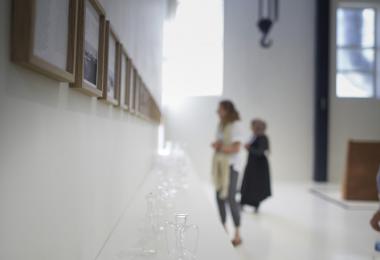
The collection presented which is part of the ongoing work ‘Hollow Forms,’ echoes and replicates the forms of actual vessels from the Levant currently held by the Metropolitan Museum of Art in New York, and takes their stories a step further by allowing the objects to “speak.”
The project sheds light on archaeological glass artifacts from the Levant that have been displaced and are currently displayed behind glass vitrines and storage boxes in western institutions. These vessels are seen as deeply critical forms in the construct of the global south's imaginary but are inaccessible to the region's audience as their stories are told by authorities with a different perspective. The display renders the vessels invisible, as they are in their current state, yet plays with the shadows of those forms to assert the mark they make on the ground. The vessels exhibited here were blown to life by the Twam family in Jaba’, Palestine.
© Amman Design Week 2019
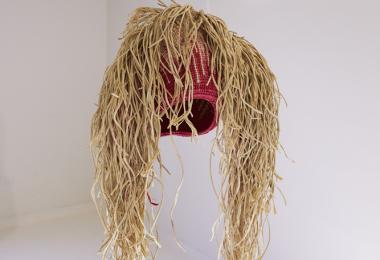
The Refugee Collection is a tribute to the struggle of Syrian refugees. The collection is constructed and twined mainly with paper rush, much like a nest, representing the need for protection and expressing the isolation of refugees in their newly adopted homes. This craftsmanship was inspired from the Syrian carpet “hasir” which was once used to decorate homes and is now constructed to give warmth to displaced people. The process involves constant weaving by adding layers in order to give curves to fit the body. The works cover the wearer to give a warm, therapeutic feeling.
© Amman Design Week 2019
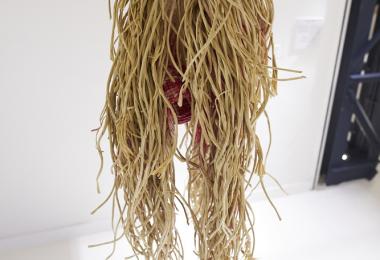
The Refugee Collection is a tribute to the struggle of Syrian refugees. The collection is constructed and twined mainly with paper rush, much like a nest, representing the need for protection and expressing the isolation of refugees in their newly adopted homes. This craftsmanship was inspired from the Syrian carpet “hasir” which was once used to decorate homes and is now constructed to give warmth to displaced people. The process involves constant weaving by adding layers in order to give curves to fit the body. The works cover the wearer to give a warm, therapeutic feeling.
© Amman Design Week 2019
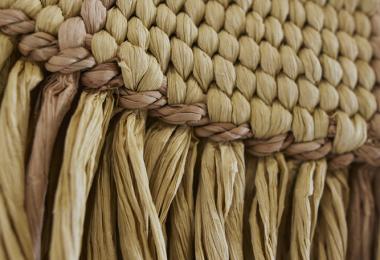
The Refugee Collection is a tribute to the struggle of Syrian refugees. The collection is constructed and twined mainly with paper rush, much like a nest, representing the need for protection and expressing the isolation of refugees in their newly adopted homes. This craftsmanship was inspired from the Syrian carpet “hasir” which was once used to decorate homes and is now constructed to give warmth to displaced people. The process involves constant weaving by adding layers in order to give curves to fit the body. The works cover the wearer to give a warm, therapeutic feeling.
© Amman Design Week 2019
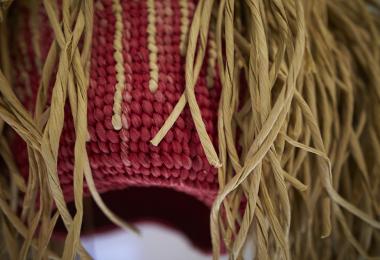
© Amman Design Week 2019
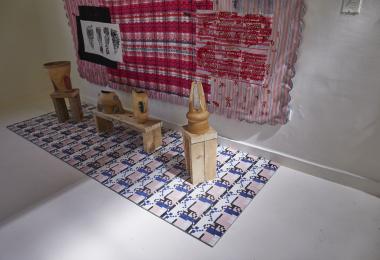
This installation started with a series of contemporary motifs inspired by the narrative and talismanic qualities of traditional Palestinian embroidery, commissioned by El-Malak to Beirut-based Studio Kawakeb. Here the designs are interpreted in several mediums and through two additional commissions: a textile print by Alexandra Saddi that is part of a patchwork of textiles forming the screen, and ceramics by Xeina Al Malki that use the embroidery motifs for their binding qualities to attach the layers of earth to each other. With bright jacquard stripes reminiscent of traditional Levantine textiles, the overall setting is in an exploration of the familiarity, expressiveness and freedom of a domestic space.
Motifs by Studio Kawakeb, textile print by Alexandra Saddi, and ceramics by Xeina Al Malki.
© Amman Design Week 2019
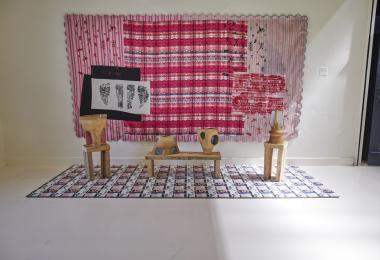
This installation started with a series of contemporary motifs inspired by the narrative and talismanic qualities of traditional Palestinian embroidery, commissioned by El-Malak to Beirut-based Studio Kawakeb. Here the designs are interpreted in several mediums and through two additional commissions: a textile print by Alexandra Saddi that is part of a patchwork of textiles forming the screen, and ceramics by Xeina Al Malki that use the embroidery motifs for their binding qualities to attach the layers of earth to each other. With bright jacquard stripes reminiscent of traditional Levantine textiles, the overall setting is in an exploration of the familiarity, expressiveness and freedom of a domestic space.
Motifs by Studio Kawakeb, textile print by Alexandra Saddi, and ceramics by Xeina Al Malki.
© Amman Design Week 2019
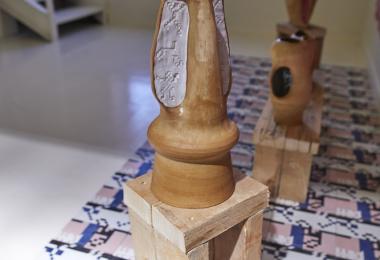
This installation started with a series of contemporary motifs inspired by the narrative and talismanic qualities of traditional Palestinian embroidery, commissioned by El-Malak to Beirut-based Studio Kawakeb. Here the designs are interpreted in several mediums and through two additional commissions: a textile print by Alexandra Saddi that is part of a patchwork of textiles forming the screen, and ceramics by Xeina Al Malki that use the embroidery motifs for their binding qualities to attach the layers of earth to each other. With bright jacquard stripes reminiscent of traditional Levantine textiles, the overall setting is in an exploration of the familiarity, expressiveness and freedom of a domestic space.
Motifs by Studio Kawakeb, textile print by Alexandra Saddi, and ceramics by Xeina Al Malki.
© Amman Design Week 2019

This installation started with a series of contemporary motifs inspired by the narrative and talismanic qualities of traditional Palestinian embroidery, commissioned by El-Malak to Beirut-based Studio Kawakeb. Here the designs are interpreted in several mediums and through two additional commissions: a textile print by Alexandra Saddi that is part of a patchwork of textiles forming the screen, and ceramics by Xeina Al Malki that use the embroidery motifs for their binding qualities to attach the layers of earth to each other. With bright jacquard stripes reminiscent of traditional Levantine textiles, the overall setting is in an exploration of the familiarity, expressiveness and freedom of a domestic space.
Motifs by Studio Kawakeb, textile print by Alexandra Saddi, and ceramics by Xeina Al Malki.
© Amman Design Week 2019
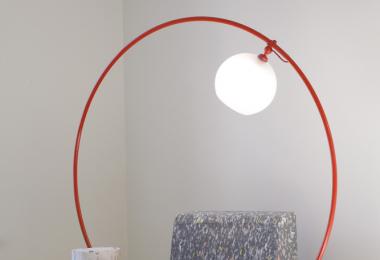
The concrete terrazzo cylinder of the lamp doubles as a coffee table and acts as an anchor to stabilize the inherently unstable shape of the hoop that holds the lighting fixture. The circle defines a space underneath the lamp where one can sit and read, giving the lamp a spatial quality.
© Amman Design Week 2019
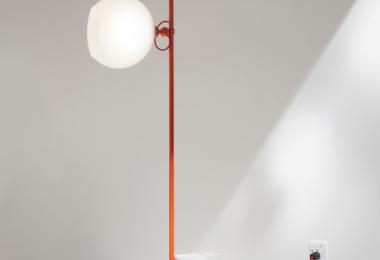
The lamp is made of concrete terrazzo with marble turned on a stone lathe, and a reshaped steel tube that is mechanically fixed to the concrete. Steel and concrete are in many ways opposite to one another; structurally, one is better for tension, the other for compression. The concrete is reduced to a heavy grounding ballast while the steel is a light weight structural element carrying the lamp. They are coupled together in order to balance and resist gravity forces.
© Amman Design Week 2019
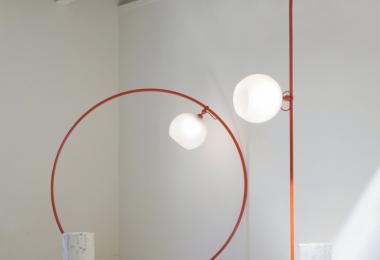
The concrete terrazzo cylinder of the lamp doubles as a coffee table and acts as an anchor to stabilize the inherently unstable shape of the hoop that holds the lighting fixture. The circle defines a space underneath the lamp where one can sit and read, giving the lamp a spatial quality.
The lamp is made of concrete terrazzo with marble turned on a stone lathe, and a reshaped steel tube that is mechanically fixed to the concrete. Steel and concrete are in many ways opposite to one another; structurally, one is better for tension, the other for compression. The concrete is reduced to a heavy grounding ballast while the steel is a light weight structural element carrying the lamp. They are coupled together in order to balance and resist gravity forces.
© Amman Design Week 2019
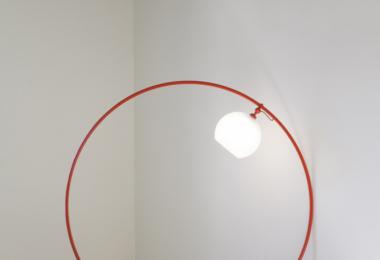
The concrete terrazzo cylinder of the lamp doubles as a coffee table and acts as an anchor to stabilize the inherently unstable shape of the hoop that holds the lighting fixture. The circle defines a space underneath the lamp where one can sit and read, giving the lamp a spatial quality.
© Amman Design Week 2019
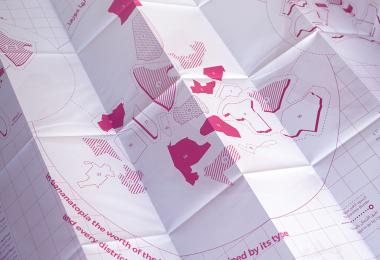
The initial idea of Bananatopia is to map the city of Cairo through the lens of segregation and social differences. An item of everyday use, the banana, was chosen as a medium to map this issue by surveying its different varieties and prices in Cairo’s main neighborhoods. This change in price and type reveals the huge differences between the districts in Cairo.
Bananatopia is an eye opener to the social problems that exist in Cairo and reveals, through the mapping of bananas, the very close proximity of extreme wealth and poverty within the city.
© Amman Design Week 2019
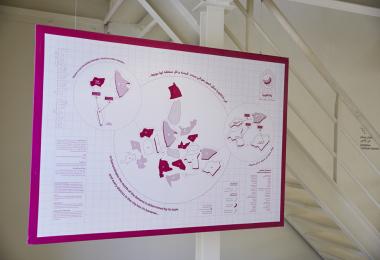
The initial idea of Bananatopia is to map the city of Cairo through the lens of segregation and social differences. An item of everyday use, the banana, was chosen as a medium to map this issue by surveying its different varieties and prices in Cairo’s main neighborhoods. This change in price and type reveals the huge differences between the districts in Cairo.
Bananatopia is an eye opener to the social problems that exist in Cairo and reveals, through the mapping of bananas, the very close proximity of extreme wealth and poverty within the city.
© Amman Design Week 2019
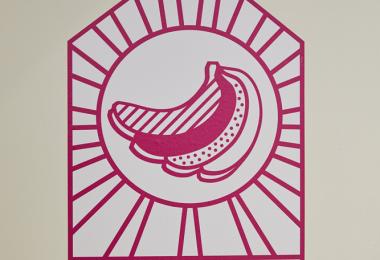
The initial idea of Bananatopia is to map the city of Cairo through the lens of segregation and social differences. An item of everyday use, the banana, was chosen as a medium to map this issue by surveying its different varieties and prices in Cairo’s main neighborhoods. This change in price and type reveals the huge differences between the districts in Cairo.
Bananatopia is an eye opener to the social problems that exist in Cairo and reveals, through the mapping of bananas, the very close proximity of extreme wealth and poverty within the city.
© Amman Design Week 2019
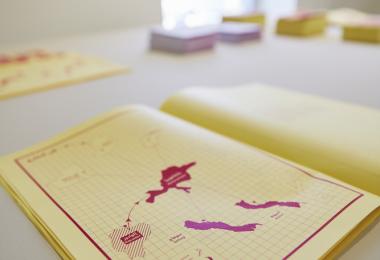
The initial idea of Bananatopia is to map the city of Cairo through the lens of segregation and social differences. An item of everyday use, the banana, was chosen as a medium to map this issue by surveying its different varieties and prices in Cairo’s main neighborhoods. This change in price and type reveals the huge differences between the districts in Cairo.
Bananatopia is an eye opener to the social problems that exist in Cairo and reveals, through the mapping of bananas, the very close proximity of extreme wealth and poverty within the city.
© Amman Design Week 2019
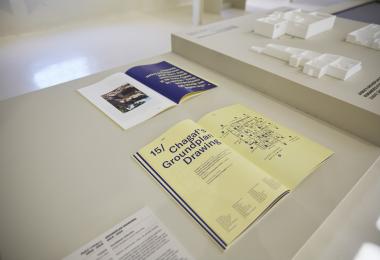
Groundplan drawings is an on-going collection of drawings made by Syrian friends and relatives who are currently living in Europe and the United States, and who were forced to leave their homes since the war broke out in 2011. It is likely that they may never return to live in their homes.
The participants were asked to draw their houses as they remember them, including memories of events inside the home, and the changes which took place in the structure of the home after and during the conflict. The participants experience making memory drawings, which is a valuable way to document places and events, to be used as evidence and catharsis.
© Amman Design Week 2019
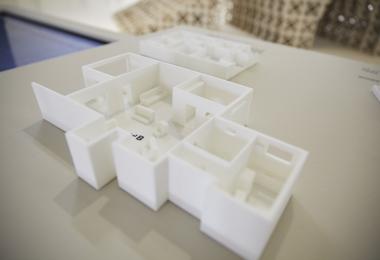
Groundplan drawings is an on-going collection of drawings made by Syrian friends and relatives who are currently living in Europe and the United States, and who were forced to leave their homes since the war broke out in 2011. It is likely that they may never return to live in their homes.
The participants were asked to draw their houses as they remember them, including memories of events inside the home, and the changes which took place in the structure of the home after and during the conflict. The participants experience making memory drawings, which is a valuable way to document places and events, to be used as evidence and catharsis.
© Amman Design Week 2019
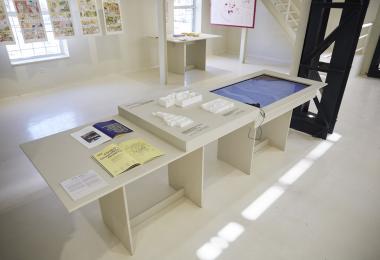
Groundplan drawings is an on-going collection of drawings made by Syrian friends and relatives who are currently living in Europe and the United States, and who were forced to leave their homes since the war broke out in 2011. It is likely that they may never return to live in their homes.
The participants were asked to draw their houses as they remember them, including memories of events inside the home, and the changes which took place in the structure of the home after and during the conflict. The participants experience making memory drawings, which is a valuable way to document places and events, to be used as evidence and catharsis.
© Amman Design Week 2019
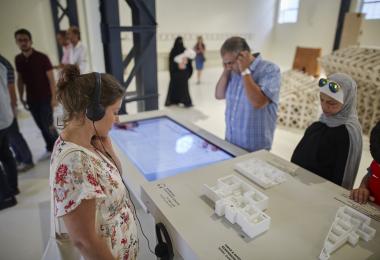
Groundplan drawings is an on-going collection of drawings made by Syrian friends and relatives who are currently living in Europe and the United States, and who were forced to leave their homes since the war broke out in 2011. It is likely that they may never return to live in their homes.
The participants were asked to draw their houses as they remember them, including memories of events inside the home, and the changes which took place in the structure of the home after and during the conflict. The participants experience making memory drawings, which is a valuable way to document places and events, to be used as evidence and catharsis.
© Amman Design Week 2019
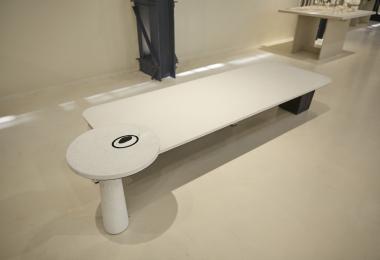
We’re observing the deterioration of our clean waters. The tables explore and invite conversation around the extent of our involvement. Longing to preserve a time and place; tell winter to wait.
The placement, volume, and density of the compressed waste throughout the pieces is deliberate. All recycled waste integrated into silica sand is left for interpretation, resonating in both a sensory and contemplative experience.
© Amman Design Week 2019

We’re observing the deterioration of our clean waters. The tables explore and invite conversation around the extent of our involvement. Longing to preserve a time and place; tell winter to wait.
The placement, volume, and density of the compressed waste throughout the pieces is deliberate. All recycled waste integrated into silica sand is left for interpretation, resonating in both a sensory and contemplative experience.
© Amman Design Week 2019
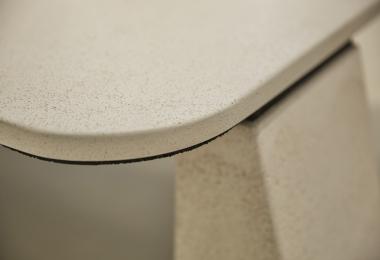
We’re observing the deterioration of our clean waters. The tables explore and invite conversation around the extent of our involvement. Longing to preserve a time and place; tell winter to wait.
The placement, volume, and density of the compressed waste throughout the pieces is deliberate. All recycled waste integrated into silica sand is left for interpretation, resonating in both a sensory and contemplative experience.
© Amman Design Week 2019
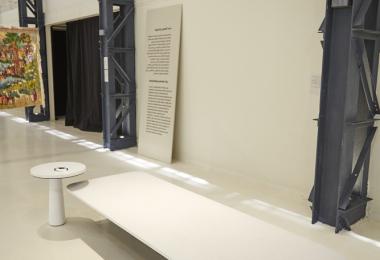
We’re observing the deterioration of our clean waters. The tables explore and invite conversation around the extent of our involvement. Longing to preserve a time and place; tell winter to wait.
The placement, volume, and density of the compressed waste throughout the pieces is deliberate. All recycled waste integrated into silica sand is left for interpretation, resonating in both a sensory and contemplative experience.
© Amman Design Week 2019
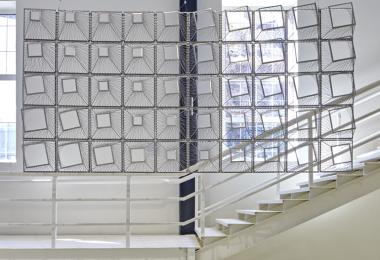
The Woven Mashrabiya is a reinterpretation of the traditional Mashrabiya facade elements. It explores the possibilities of translating this historical craft into a contemporary modular system. The modular system allows endless possibilities for assembly at different scales and configurations. By using light-weight materials, the modules can be arranged to create various forms of enclosures, planar facades, partitions and shading canopies.This allows the system to re-adapt to different locations.
The modules are created by weaving wire through a base frame. By changing the base geometry of the frame, variations in aperture size, rotation and shape can be created. Transparency is manipulated to change the overall perception of a space and create variety in the amount of light permeating the facade, similar to the effects created in a traditional Mashrabiya.
Photo by Edmund Sumner
© Amman Design Week 2019
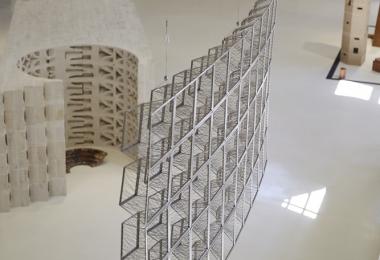
The Woven Mashrabiya is a reinterpretation of the traditional Mashrabiya facade elements. It explores the possibilities of translating this historical craft into a contemporary modular system. The modular system allows endless possibilities for assembly at different scales and configurations. By using light-weight materials, the modules can be arranged to create various forms of enclosures, planar facades, partitions and shading canopies.This allows the system to re-adapt to different locations.
The modules are created by weaving wire through a base frame. By changing the base geometry of the frame, variations in aperture size, rotation and shape can be created. Transparency is manipulated to change the overall perception of a space and create variety in the amount of light permeating the facade, similar to the effects created in a traditional Mashrabiya.
© Amman Design Week 2019
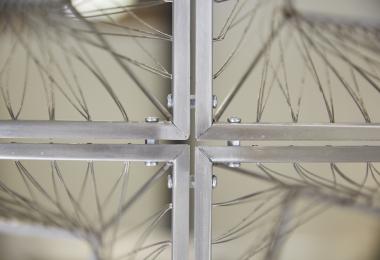
The Woven Mashrabiya is a reinterpretation of the traditional Mashrabiya facade elements. It explores the possibilities of translating this historical craft into a contemporary modular system. The modular system allows endless possibilities for assembly at different scales and configurations. By using light-weight materials, the modules can be arranged to create various forms of enclosures, planar facades, partitions and shading canopies.This allows the system to re-adapt to different locations.
The modules are created by weaving wire through a base frame. By changing the base geometry of the frame, variations in aperture size, rotation and shape can be created. Transparency is manipulated to change the overall perception of a space and create variety in the amount of light permeating the facade, similar to the effects created in a traditional Mashrabiya.
© Amman Design Week 2019
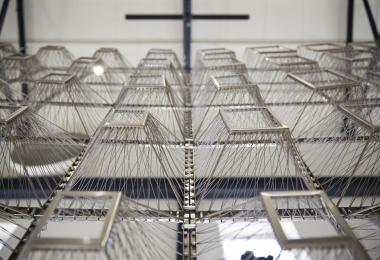
The Woven Mashrabiya is a reinterpretation of the traditional Mashrabiya facade elements. It explores the possibilities of translating this historical craft into a contemporary modular system. The modular system allows endless possibilities for assembly at different scales and configurations. By using light-weight materials, the modules can be arranged to create various forms of enclosures, planar facades, partitions and shading canopies.This allows the system to re-adapt to different locations.
The modules are created by weaving wire through a base frame. By changing the base geometry of the frame, variations in aperture size, rotation and shape can be created. Transparency is manipulated to change the overall perception of a space and create variety in the amount of light permeating the facade, similar to the effects created in a traditional Mashrabiya.
© Amman Design Week 2019
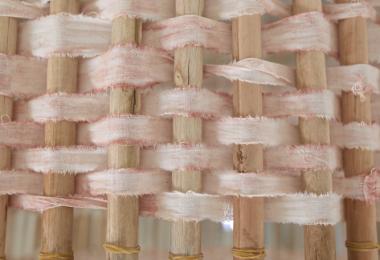
In this piece, the viewer is invited to enter a world that is constructed of fabric; one that is both soft and tactile, but also rigid and structured. It provides a sanctuary and a place for personal reflection and brings the viewer back into the realm of the hand-made. Viewers are invited to enter the artist’s world of textiles and the endless opportunities they bring, essentially making it “a room of their own”.
The piece is made of cotton, silk, linen, jute, oak and mud.
© Amman Design Week 2019
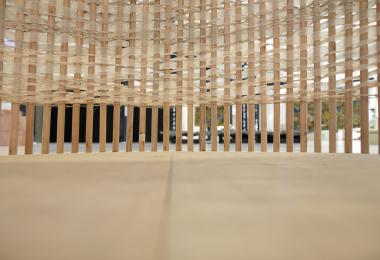
In this piece, the viewer is invited to enter a world that is constructed of fabric; one that is both soft and tactile, but also rigid and structured. It provides a sanctuary and a place for personal reflection and brings the viewer back into the realm of the hand-made. Viewers are invited to enter the artist’s world of textiles and the endless opportunities they bring, essentially making it “a room of their own”.
The piece is made of cotton, silk, linen, jute, oak and mud.
© Amman Design Week 2019

In this piece, the viewer is invited to enter a world that is constructed of fabric; one that is both soft and tactile, but also rigid and structured. It provides a sanctuary and a place for personal reflection and brings the viewer back into the realm of the hand-made. Viewers are invited to enter the artist’s world of textiles and the endless opportunities they bring, essentially making it “a room of their own”.
The piece is made of cotton, silk, linen, jute, oak and mud.
© Amman Design Week 2019

In this piece, the viewer is invited to enter a world that is constructed of fabric; one that is both soft and tactile, but also rigid and structured. It provides a sanctuary and a place for personal reflection and brings the viewer back into the realm of the hand-made. Viewers are invited to enter the artist’s world of textiles and the endless opportunities they bring, essentially making it “a room of their own”.
The piece is made of cotton, silk, linen, jute, oak and mud.
© Amman Design Week 2019

With frequent interruption of electricity in the camp, studying for children and youth in the evenings can be very challenging – especially since there is often no light. Furthermore, young people in the camps prefer to study in the outskirts since caravans are crowded and often with no lighting. Young people currently overcome this by using a phone flashlight or a solar-energy lamp. While this is not sufficient or always convenient, innovators Ibrahim and Mohammad have developed a battery-powered pen with an LED light that lights the words that are being written or read when lighting isn’t available.
This low-cost pen is conveniently rechargeable, is easily carried by a clip that can be attached to a pocket, and serves multiple target groups including frequent travelers.
This piece was supported by ONExUNICEF program (UNICEF Jordan and the One Foundation).
© Amman Design Week 2019
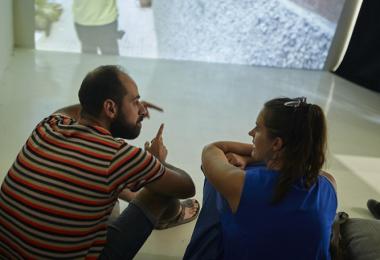
This work is a long-term research project developed until now in seven different cities: Seoul, Bogota, Naples, Saint Petersburg, Rabat, Kyoto and Tokyo. Born as an artistic commission for the Agora Biennale in Bordeaux around the theme of the moving landscapes, these videos plunge into cities in a spontaneous and subjective approach with very modest means in order to translate in the closest possible way the feeling of their constantly moving nature: their human landscape.
Presented in a comparative dynamic through the lens of a selection of themes and issues linked with daily street life, the videos enable us to perceive each of these different urban contexts as an experimental, local and unique laboratory, answering the same global challenge of how we can all live together.
The series were filmed in: Seoul, Bogota, Naples, Saint Petersburg, Rabat, Kyoto and Tokyo.
© Amman Design Week 2019
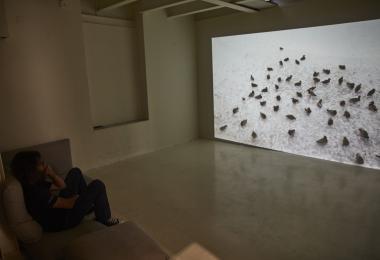
This work is a long-term research project developed until now in seven different cities: Seoul, Bogota, Naples, Saint Petersburg, Rabat, Kyoto and Tokyo. Born as an artistic commission for the Agora Biennale in Bordeaux around the theme of the moving landscapes, these videos plunge into cities in a spontaneous and subjective approach with very modest means in order to translate in the closest possible way the feeling of their constantly moving nature: their human landscape.
Presented in a comparative dynamic through the lens of a selection of themes and issues linked with daily street life, the videos enable us to perceive each of these different urban contexts as an experimental, local and unique laboratory, answering the same global challenge of how we can all live together.
The series were filmed in: Seoul, Bogota, Naples, Saint Petersburg, Rabat, Kyoto and Tokyo.
© Amman Design Week 2019

This work is a long-term research project developed until now in seven different cities: Seoul, Bogota, Naples, Saint Petersburg, Rabat, Kyoto and Tokyo. Born as an artistic commission for the Agora Biennale in Bordeaux around the theme of the moving landscapes, these videos plunge into cities in a spontaneous and subjective approach with very modest means in order to translate in the closest possible way the feeling of their constantly moving nature: their human landscape.
Presented in a comparative dynamic through the lens of a selection of themes and issues linked with daily street life, the videos enable us to perceive each of these different urban contexts as an experimental, local and unique laboratory, answering the same global challenge of how we can all live together.
The series were filmed in: Seoul, Bogota, Naples, Saint Petersburg, Rabat, Kyoto and Tokyo.
© Amman Design Week 2019
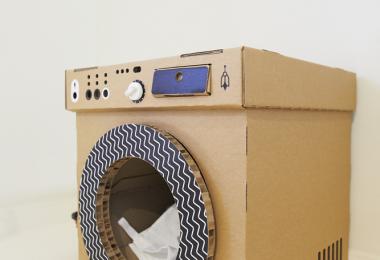
Children love pretending to play with adult products and this piece gives them exactly that joy. This toy comes with all the basic pieces of a regular washing machine: a front-load door, knobs to control the settings, and space for kids to put and "wash" their clothes in. Like the rest of the pieces in this collection, the washing machine is fun to assemble and can easily be flat-packed and stored away.
© Amman Design Week 2019
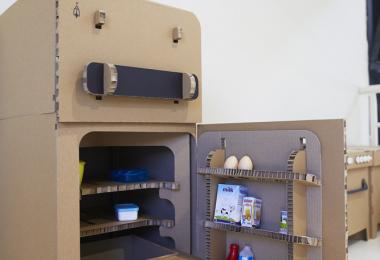
A modular, affordable, easy to assemble and disassemble flat-packed set of kitchen appliances for children aged 3+. Designed as a replica of a kitchen, each part of this set will not only entertain a child during assembly but will also teach them the manners of cleaning up after usage since it is designed to be easily disassembled and packed.
© Amman Design Week 2019

A modular, affordable, easy to assemble and disassemble flat-packed set of kitchen appliances for children aged 3+. Designed as a replica of a kitchen, each part of this set will not only entertain a child during assembly but will also teach them the manners of cleaning up after usage since it is designed to be easily disassembled and packed.
© Amman Design Week 2019
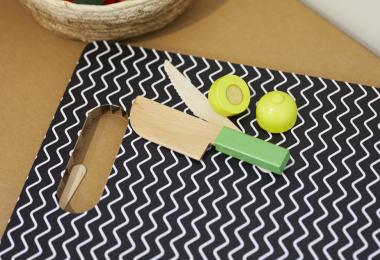
A modular, affordable, easy to assemble and disassemble flat-packed set of kitchen appliances for children aged 3+. Designed as a replica of a kitchen, each part of this set will not only entertain a child during assembly but will also teach them the manners of cleaning up after usage since it is designed to be easily disassembled and packed.
© Amman Design Week 2019

This toy is designed to be easily assembled and taken apart and requires minimal storage space as it can be completely flat-packed after disassembly.
© Amman Design Week 2019
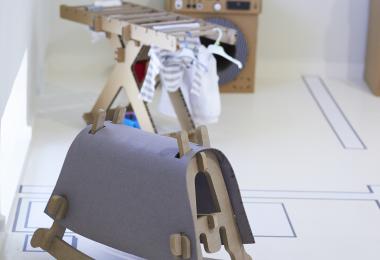
This toy is designed to be easily assembled and taken apart and requires minimal storage space as it can be completely flat-packed after disassembly.
© Amman Design Week 2019

In traditional Bedouin domestic tents, the walls, ceilings, and floors are made of woven goat's hair and sheep's wool. Traditionally, these elements were woven as separate panels on a floor loom and then sewn together to create the larger surfaces of the tent.
In architecture, numerous people and skill-sets are involved in building a home, whereas in traditional Bedouin tent-making, the main skill is weaving, practiced by women exclusively. This work is a celebration of the making of the Bedouin home with all of its soft components – floor, walls, and ceiling – being woven simultaneously as one continuous textile, dressed over a wooden frame. The weaver sits inside this frame and weaves the circular warp. The home is being woven from within, inhabited as it is being created. As the woven textile grows longer, it rotates around the box, creating a woven space – the Bedouin home.
© Amman Design Week 2019

In traditional Bedouin domestic tents, the walls, ceilings, and floors are made of woven goat's hair and sheep's wool. Traditionally, these elements were woven as separate panels on a floor loom and then sewn together to create the larger surfaces of the tent.
In architecture, numerous people and skill-sets are involved in building a home, whereas in traditional Bedouin tent-making, the main skill is weaving, practiced by women exclusively. This work is a celebration of the making of the Bedouin home with all of its soft components – floor, walls, and ceiling – being woven simultaneously as one continuous textile, dressed over a wooden frame. The weaver sits inside this frame and weaves the circular warp. The home is being woven from within, inhabited as it is being created. As the woven textile grows longer, it rotates around the box, creating a woven space – the Bedouin home.
© Amman Design Week 2019
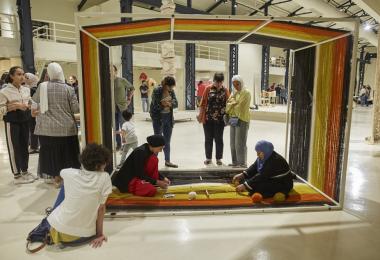
In traditional Bedouin domestic tents, the walls, ceilings, and floors are made of woven goat's hair and sheep's wool. Traditionally, these elements were woven as separate panels on a floor loom and then sewn together to create the larger surfaces of the tent.
In architecture, numerous people and skill-sets are involved in building a home, whereas in traditional Bedouin tent-making, the main skill is weaving, practiced by women exclusively. This work is a celebration of the making of the Bedouin home with all of its soft components – floor, walls, and ceiling – being woven simultaneously as one continuous textile, dressed over a wooden frame. The weaver sits inside this frame and weaves the circular warp. The home is being woven from within, inhabited as it is being created. As the woven textile grows longer, it rotates around the box, creating a woven space – the Bedouin home.
© Amman Design Week 2019
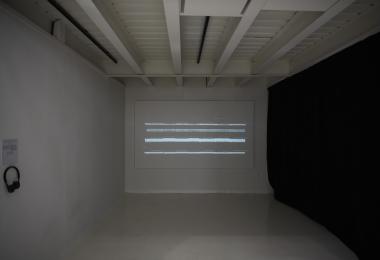
"To Practice a Place" is a video installation visually investigating the Levantine Dabkeh folk dance. Dabkeh gestures and body movements are anchored in land and geography and are derived from rhythms of the different landscapes of the Levant. This work devises performative mapping tools to create a comparative study on the variations of Dabkeh through geopolitical and transnational landscapes. installation visually investigating the Levantine Dabkeh folk dance.
© Amman Design Week 2019
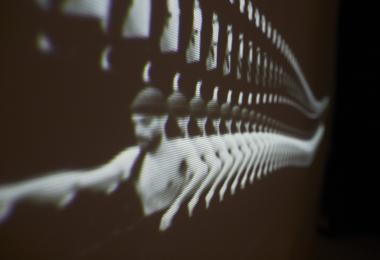
“To Practice a Place“ is a video installation visually investigating the Levantine Dabkeh folk dance. Dabkeh gestures and body movements are anchored in land and geography and are derived from rhythms of the different landscapes of the Levant. This work devises performative mapping tools to create a comparative study on the variations of Dabkeh through geopolitical and transnational landscapes.
© Amman Design Week 2019
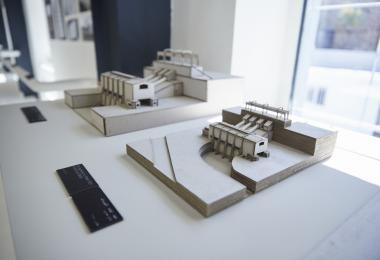
Al Baqourah is an abandoned and restricted military zone area in the Northern Jordan Valley, located on the border between Jordan and Occupied Palestine. On October 26, 1994, as part of the peace treaty, Al-Baqourah was one of the regions along the border which was placed under a “special regime” that guaranteed leasing the region to “Israel” for a period of 25 years.
The research project consists of a series of photography and documentation, through the interpretation of the concept of HETEROTOPIA (‘hetero’ - different/other and ‘topic’ place). Also, by uncovering the inaccessible fragments of the site and responding to the issue of the area's inaccessibility and state of abandonment, we allow it to be hypothetically revisited and give the visitors the opportunity to experience it from afar, interpreting the concept of here and there. It unfolds a journey of discovery and a celebration of a place - leading to a mystery that remains unsolved with an uncertain future.
© Amman Design Week 2019
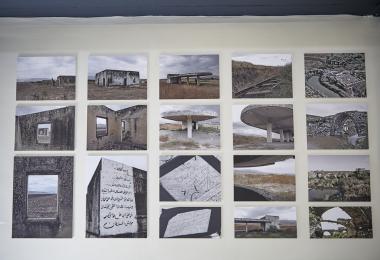
Al Baqourah is an abandoned and restricted military zone area in the Northern Jordan Valley, located on the border between Jordan and Occupied Palestine. On October 26, 1994, as part of the peace treaty, Al-Baqourah was one of the regions along the border which was placed under a “special regime” that guaranteed leasing the region to “Israel” for a period of 25 years.
The research project consists of a series of photography and documentation, through the interpretation of the concept of HETEROTOPIA (‘hetero’ - different/other and ‘topic’ place). Also, by uncovering the inaccessible fragments of the site and responding to the issue of the area's inaccessibility and state of abandonment, we allow it to be hypothetically revisited and give the visitors the opportunity to experience it from afar, interpreting the concept of here and there. It unfolds a journey of discovery and a celebration of a place - leading to a mystery that remains unsolved with an uncertain future.
© Amman Design Week 2019
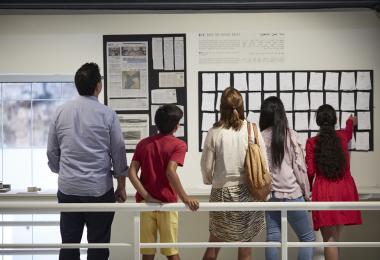
Al Baqourah is an abandoned and restricted military zone area in the Northern Jordan Valley, located on the border between Jordan and Occupied Palestine. On October 26, 1994, as part of the peace treaty, Al-Baqourah was one of the regions along the border which was placed under a “special regime” that guaranteed leasing the region to “Israel” for a period of 25 years.
The research project consists of a series of photography and documentation, through the interpretation of the concept of HETEROTOPIA (‘hetero’ - different/other and ‘topic’ place). Also, by uncovering the inaccessible fragments of the site and responding to the issue of the area's inaccessibility and state of abandonment, we allow it to be hypothetically revisited and give the visitors the opportunity to experience it from afar, interpreting the concept of here and there. It unfolds a journey of discovery and a celebration of a place - leading to a mystery that remains unsolved with an uncertain future.
© Amman Design Week 2019
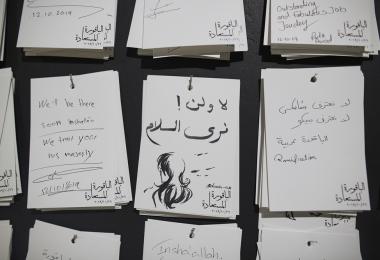
Al Baqourah is an abandoned and restricted military zone area in the Northern Jordan Valley, located on the border between Jordan and Occupied Palestine. On October 26, 1994, as part of the peace treaty, Al-Baqourah was one of the regions along the border which was placed under a “special regime” that guaranteed leasing the region to “Israel” for a period of 25 years.
The research project consists of a series of photography and documentation, through the interpretation of the concept of HETEROTOPIA (‘hetero’ - different/other and ‘topic’ place). Also, by uncovering the inaccessible fragments of the site and responding to the issue of the area's inaccessibility and state of abandonment, we allow it to be hypothetically revisited and give the visitors the opportunity to experience it from afar, interpreting the concept of here and there. It unfolds a journey of discovery and a celebration of a place - leading to a mystery that remains unsolved with an uncertain future.
© Amman Design Week 2019
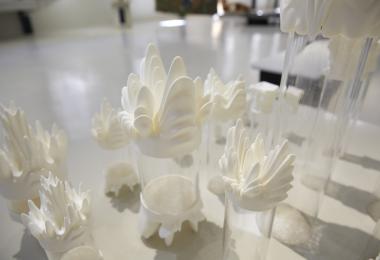
Fascinated by the relationship between body and space, emergent technologies enable us to bridge between both scales. While current reflections on technologies focus on the materiality of 3D printing and digital design processes to create various spatial forms, this work instead aims to investigate the meaning of scale.
Inspired by an in-depth research conducted between 2014 and 2018 into Petra's columns, capitals and crowns, Columns to Crowns is a collection of objects which bridge morphology, scale, and expression to showcase possibilities.
© Amman Design Week 2019
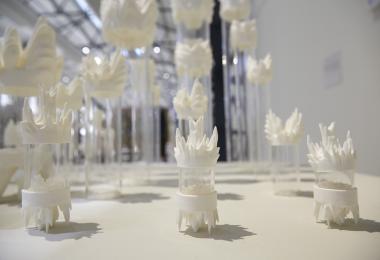
Fascinated by the relationship between body and space, emergent technologies enable us to bridge between both scales. While current reflections on technologies focus on the materiality of 3D printing and digital design processes to create various spatial forms, this work instead aims to investigate the meaning of scale.
Inspired by an in-depth research conducted between 2014 and 2018 into Petra's columns, capitals and crowns, Columns to Crowns is a collection of objects which bridge morphology, scale, and expression to showcase possibilities.
© Amman Design Week 2019
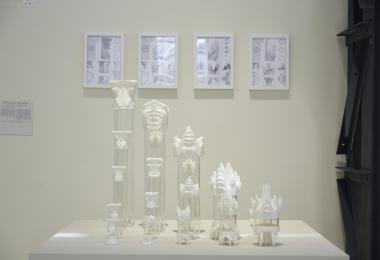
Fascinated by the relationship between body and space, emergent technologies enable us to bridge between both scales. While current reflections on technologies focus on the materiality of 3D printing and digital design processes to create various spatial forms, this work instead aims to investigate the meaning of scale.
Inspired by an in-depth research conducted between 2014 and 2018 into Petra's columns, capitals and crowns, Columns to Crowns is a collection of objects which bridge morphology, scale, and expression to showcase possibilities.
© Amman Design Week 2019
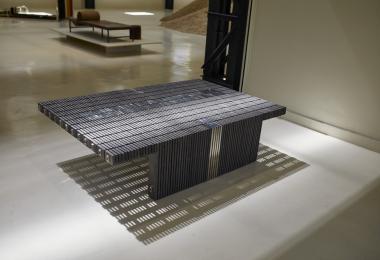
Stone Weave is a coffee table composed of 2000 hand-sawed, polished, and woven pieces of stone. The stone slab is reduced into smaller threaded units interlaced with metal threads, forming a weaving system that is similar to the process of weaving a carpet, where the weave has no limit.
© Amman Design Week 2019
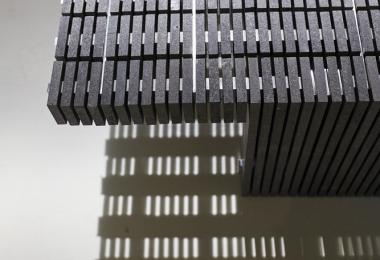
Stone Weave is a coffee table composed of 2000 hand-sawed, polished, and woven pieces of stone. The stone slab is reduced into smaller threaded units interlaced with metal threads, forming a weaving system that is similar to the process of weaving a carpet, where the weave has no limit.
© Amman Design Week 2019
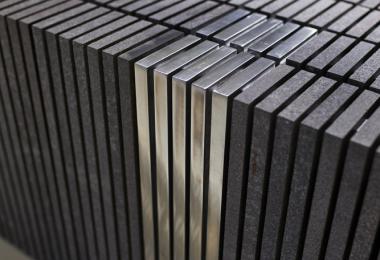
Stone Weave is a coffee table composed of 2000 hand-sawed, polished, and woven pieces of stone. The stone slab is reduced into smaller threaded units interlaced with metal threads, forming a weaving system that is similar to the process of weaving a carpet, where the weave has no limit.
© Amman Design Week 2019
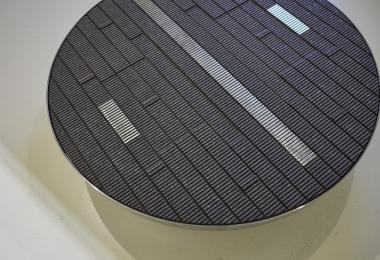
rho (p) is the mathematical symbol for density.
This coffee table is composed of a core and an outer shell. The core is made out of an assembly of 1000 hand-sawed stone pieces and covered with a polished stainless steel shell.
The object serves as an expression of density and the act of cleaving.
© Amman Design Week 2019
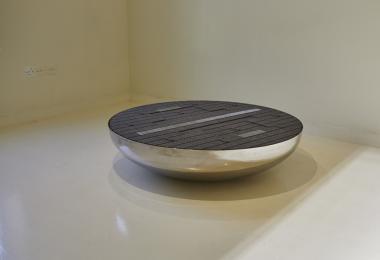
rho (p) is the mathematical symbol for density.
This coffee table is composed of a core and an outer shell. The core is made out of an assembly of 1000 hand-sawed stone pieces and covered with a polished stainless steel shell.
The object serves as an expression of density and the act of cleaving.
© Amman Design Week 2019
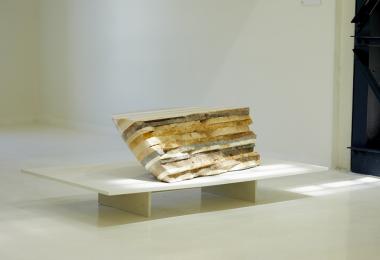
A cantilevered coffee table is carved out of a new type of kutleh block to form a limited edition piece. The natural state of stone and marble is exposed in this block that is made of repurposed stone. The sourced stone was was handpicked for its natural splits created by the endless possibilities of nature’s making. These splits occur along the seamless veins that form it; veins that form with time, and break with age. The block returns to the origin of stone, where possibilities are boundless, and yet remain directly connected to the essence of the material.
© Amman Design Week 2019
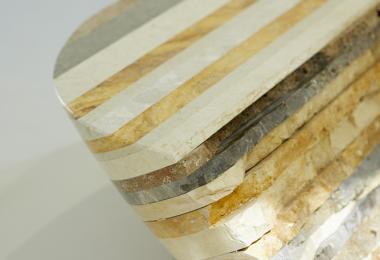
A cantilevered coffee table is carved out of a new type of kutleh block to form a limited edition piece. The natural state of stone and marble is exposed in this block that is made of repurposed stone. The sourced stone was was handpicked for its natural splits created by the endless possibilities of nature’s making. These splits occur along the seamless veins that form it; veins that form with time, and break with age. The block returns to the origin of stone, where possibilities are boundless, and yet remain directly connected to the essence of the material.
© Amman Design Week 2019
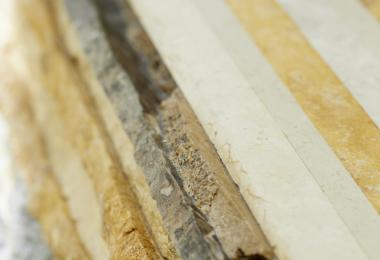
The table was made of repurposed stone.
© Amman Design Week 2019

A cantilevered coffee table is carved out of a new type of kutleh block to form a limited edition piece. The natural state of stone and marble is exposed in this block that is made of repurposed stone. The sourced stone was was handpicked for its natural splits created by the endless possibilities of nature’s making. These splits occur along the seamless veins that form it; veins that form with time, and break with age. The block returns to the origin of stone, where possibilities are boundless, and yet remain directly connected to the essence of the material.
© Amman Design Week 2019
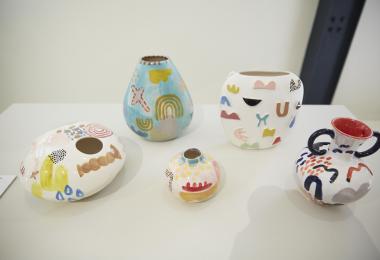
This hand-painted collection of ceramics are inspired by the various feelings you may have when traveling alone; when you're caught in the rain without an umbrella in the thick summer air, when you have a playful moment with a strangers' baby on the metro, when you have a language barrier and revert to presumed globally understood hand gestures to communicate.
© Amman Design Week 2019

This hand-painted collection of ceramics are inspired by the various feelings you may have when traveling alone; when you're caught in the rain without an umbrella in the thick summer air, when you have a playful moment with a strangers' baby on the metro, when you have a language barrier and revert to presumed globally understood hand gestures to communicate.
© Amman Design Week 2019
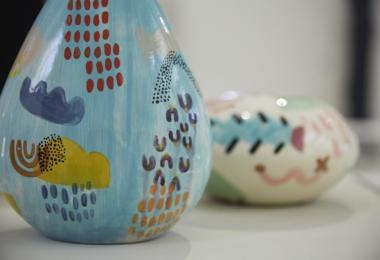
This hand-painted collection of ceramics are inspired by the various feelings you may have when traveling alone; when you're caught in the rain without an umbrella in the thick summer air, when you have a playful moment with a strangers' baby on the metro, when you have a language barrier and revert to presumed globally understood hand gestures to communicate.
© Amman Design Week 2019

This hand-painted collection of ceramics are inspired by the various feelings you may have when traveling alone; when you're caught in the rain without an umbrella in the thick summer air, when you have a playful moment with a strangers' baby on the metro, when you have a language barrier and revert to presumed globally understood hand gestures to communicate.
© Amman Design Week 2019
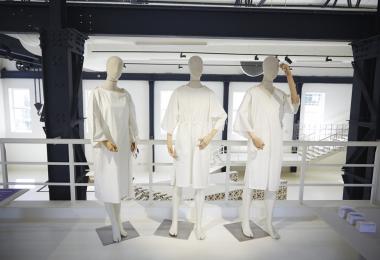
"hale" is a project that aims to upgrade patient hospital attire as a progression towards a new generation of integration between design and technology. It serves patients’ and doctors’ essential daily needs through three different patient gowns: the disposable, the launderable, and the sensor gown.
© Amman Design Week 2019
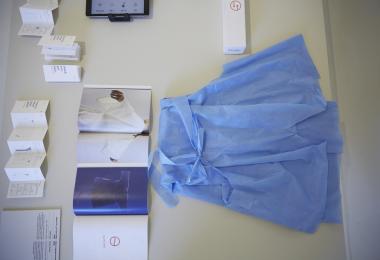
"hale" is a project that aims to upgrade patient hospital attire as a progression towards a new generation of integration between design and technology. It serves patients’ and doctors’ essential daily needs through three different patient gowns: the disposable, the launderable, and the sensor gown.
© Amman Design Week 2019
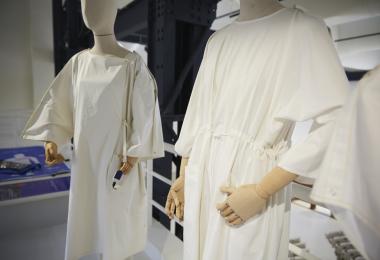
"hale" is a project that aims to upgrade patient hospital attire as a progression towards a new generation of integration between design and technology. It serves patients’ and doctors’ essential daily needs through three different patient gowns: the disposable, the launderable, and the sensor gown.
© Amman Design Week 2019
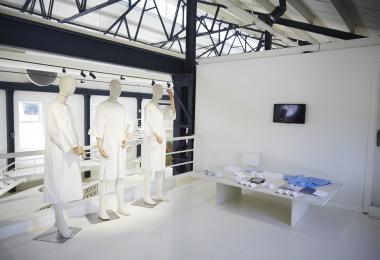
"hale" is a project that aims to upgrade patient hospital attire as a progression towards a new generation of integration between design and technology. It serves patients’ and doctors’ essential daily needs through three different patient gowns: the disposable, the launderable, and the sensor gown.
© Amman Design Week 2019
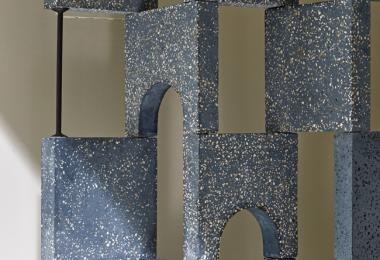
The ambition of “Let’s go terrazzo” is to revive the Jordanian terrazzo industry by reintroducing this modest and recycled material in more fresh finishes, colors and patterns; while exploring its wide potential in designing different interior elements, such as tiles, partitions, objects, and furniture.
Photo by Edmund Sumner
© Amman Design Week 2019
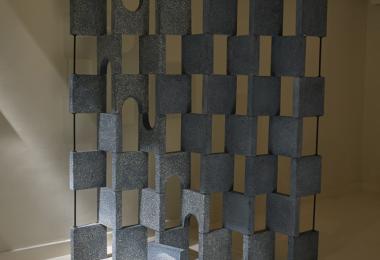
The ambition of “Let’s go terrazzo” is to revive the Jordanian terrazzo industry by reintroducing this modest and recycled material in more fresh finishes, colors and patterns; while exploring its wide potential in designing different interior elements, such as tiles, partitions, objects, and furniture.
© Amman Design Week 2019
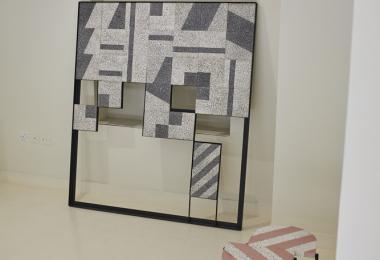
The ambition of “Let’s go terrazzo” is to revive the Jordanian terrazzo industry by reintroducing this modest and recycled material in more fresh finishes, colors and patterns; while exploring its wide potential in designing different interior elements, such as tiles, partitions, objects, and furniture.
© Amman Design Week 2019
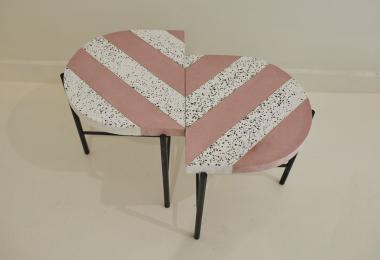
The ambition of “Let’s go terrazzo” is to revive the Jordanian terrazzo industry by reintroducing this modest and recycled material in more fresh finishes, colors and patterns; while exploring its wide potential in designing different interior elements, such as tiles, partitions, objects, and furniture.
© Amman Design Week 2019

The ambition of “Let’s go terrazzo” is to revive the Jordanian terrazzo industry by reintroducing this modest and recycled material in more fresh finishes, colors and patterns; while exploring its wide potential in designing different interior elements, such as tiles, partitions, objects, and furniture.
© Amman Design Week 2019
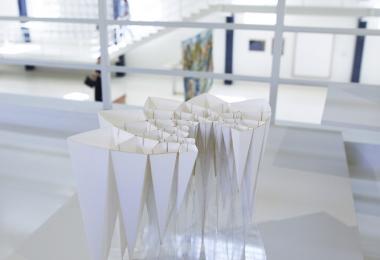
Functional Ornament is a series of paper models that explore the potential of ornate islamic geometric compositions as functional house-hold objects. Although islamic geometries have been used as surface compositions, very little evidence of their use in three-dimensional forms exists, whether as sculptural or spatial iterations, since they are often romanticized and rarely seen as functional. The project serves to challenge this understanding wherein the geometrical explorations question and challenge the possible functionalism of these patterns.
Functional Ornaments through the use of a paper-folding technique adds an ephemeral aspect, in which the pieces can be disassembled and flattened to their two-dimensional elements and reassembled multiple times, referring to the nomadic traditions of bedouins coffee culture and thus rendering themselves as highly ‘functional’.
© Amman Design Week 2019
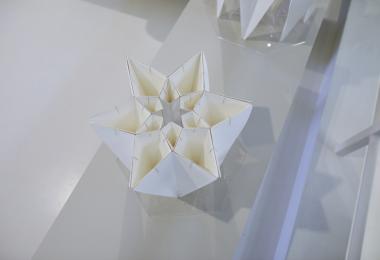
Functional Ornament is a series of paper models that explore the potential of ornate islamic geometric compositions as functional house-hold objects. Although islamic geometries have been used as surface compositions, very little evidence of their use in three-dimensional forms exists, whether as sculptural or spatial iterations, since they are often romanticized and rarely seen as functional. The project serves to challenge this understanding wherein the geometrical explorations question and challenge the possible functionalism of these patterns.
Functional Ornaments through the use of a paper-folding technique adds an ephemeral aspect, in which the pieces can be disassembled and flattened to their two-dimensional elements and reassembled multiple times, referring to the nomadic traditions of bedouins coffee culture and thus rendering themselves as highly ‘functional’.
© Amman Design Week 2019
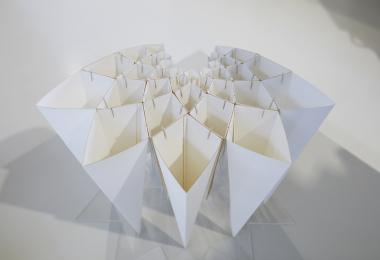
Functional Ornament is a series of paper models that explore the potential of ornate islamic geometric compositions as functional house-hold objects. Although islamic geometries have been used as surface compositions, very little evidence of their use in three-dimensional forms exists, whether as sculptural or spatial iterations, since they are often romanticized and rarely seen as functional. The project serves to challenge this understanding wherein the geometrical explorations question and challenge the possible functionalism of these patterns.
Functional Ornaments through the use of a paper-folding technique adds an ephemeral aspect, in which the pieces can be disassembled and flattened to their two-dimensional elements and reassembled multiple times, referring to the nomadic traditions of bedouins coffee culture and thus rendering themselves as highly ‘functional’.
© Amman Design Week 2019
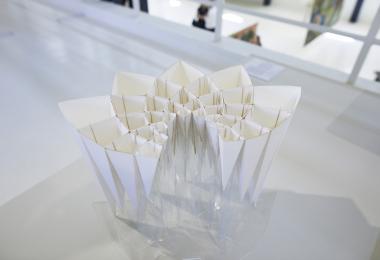
Functional Ornament is a series of paper models that explore the potential of ornate islamic geometric compositions as functional house-hold objects. Although islamic geometries have been used as surface compositions, very little evidence of their use in three-dimensional forms exists, whether as sculptural or spatial iterations, since they are often romanticized and rarely seen as functional. The project serves to challenge this understanding wherein the geometrical explorations question and challenge the possible functionalism of these patterns.
Functional Ornaments through the use of a paper-folding technique adds an ephemeral aspect, in which the pieces can be disassembled and flattened to their two-dimensional elements and reassembled multiple times, referring to the nomadic traditions of bedouins coffee culture and thus rendering themselves as highly ‘functional’.
© Amman Design Week 2019
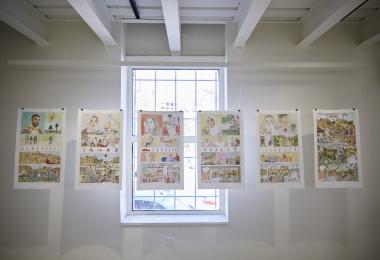
Amman ya Amman explores the complex narratives of five individuals, Ahmad, Hala, Zaina, Jamila and Abu Rashid who are all living in Amman. Each character navigates and experiences the city in varied ways. The comic style elicits the collective imaginations of the city and how each character understands their future within it.
© Amman Design Week 2019
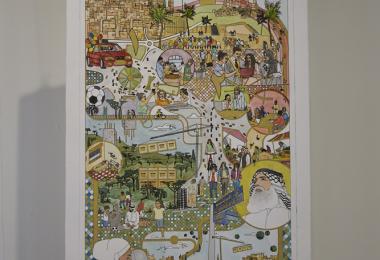
Amman ya Amman explores the complex narratives of five individuals, Ahmad, Hala, Zaina, Jamila and Abu Rashid who are all living in Amman. Each character navigates and experiences the city in varied ways. The comic style elicits the collective imaginations of the city and how each character understands their future within it.
© Amman Design Week 2019
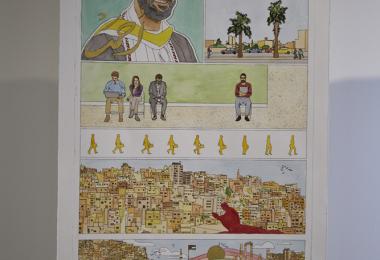
Amman ya Amman explores the complex narratives of five individuals, Ahmad, Hala, Zaina, Jamila and Abu Rashid who are all living in Amman. Each character navigates and experiences the city in varied ways. The comic style elicits the collective imaginations of the city and how each character understands their future within it.
© Amman Design Week 2019

In El Zein’s Seduction Series, a pair of forms begin detached from one another and through a series of sequential steps, gradually intertwine. Though abstract, the shapes can be read as symbolic of two people falling slowly into an embrace – the poetic essence of an emotional relationship. The contours are hand-shaped, creating a nuanced sensual effect evoking the limbs and clefts of the human body. For Seduction, Pair 06, El Zein executes these shapes as a sculptural seat in red travertine.
© Amman Design Week 2019
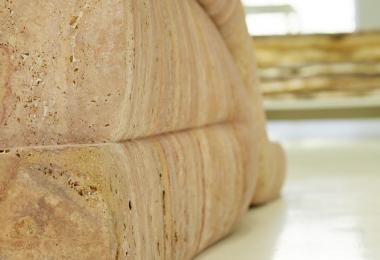
In El Zein’s Seduction Series, a pair of forms begin detached from one another and through a series of sequential steps, gradually intertwine. Though abstract, the shapes can be read as symbolic of two people falling slowly into an embrace – the poetic essence of an emotional relationship. The contours are hand-shaped, creating a nuanced sensual effect evoking the limbs and clefts of the human body. For Seduction, Pair 06, El Zein executes these shapes as a sculptural seat in red travertine.
© Amman Design Week 2019
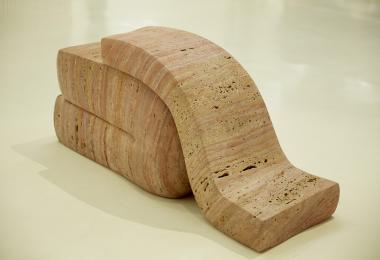
In El Zein’s Seduction Series, a pair of forms begin detached from one another and through a series of sequential steps, gradually intertwine. Though abstract, the shapes can be read as symbolic of two people falling slowly into an embrace – the poetic essence of an emotional relationship. The contours are hand-shaped, creating a nuanced sensual effect evoking the limbs and clefts of the human body. For Seduction, Pair 06, El Zein executes these shapes as a sculptural seat in red travertine.
© Amman Design Week 2019
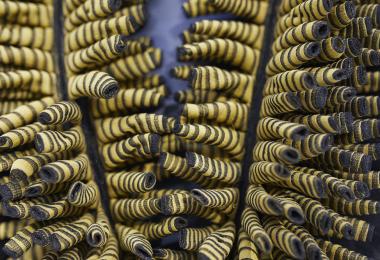
Materiality plays a central role in the work of Nourredine Amir. It is a starting point through which the dress is born from the material in an intuitive process of making and shaping. He starts with the size of the dress and never knows when the process stops. His universe is one of free creation, which taunts gravity, the usual, and the agreed upon, and where the trance of creation allows him to find the path he seeks. These raw and natural materials inspire his collections that are often presented in small palettes representative of the beauty of nature. Chosen with care and tamed by wire, the materials undergo a real metamorphosis. It is an art in itself that highlights the wealth of Moroccan craftsmanship by bringing it a real reflection.
© Amman Design Week 2019
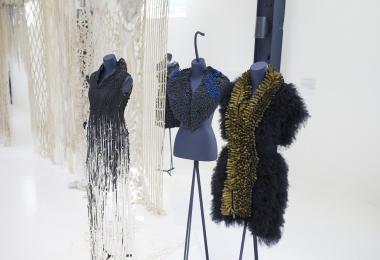
Materiality plays a central role in the work of Nourredine Amir. It is a starting point through which the dress is born from the material in an intuitive process of making and shaping. He starts with the size of the dress and never knows when the process stops. His universe is one of free creation, which taunts gravity, the usual, and the agreed upon, and where the trance of creation allows him to find the path he seeks. These raw and natural materials inspire his collections that are often presented in small palettes representative of the beauty of nature. Chosen with care and tamed by wire, the materials undergo a real metamorphosis. It is an art in itself that highlights the wealth of Moroccan craftsmanship by bringing it a real reflection.
© Amman Design Week 2019
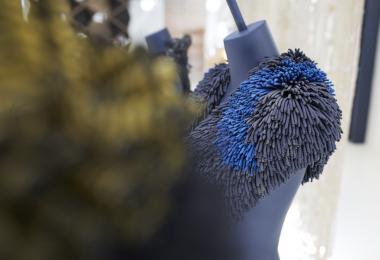
Materiality plays a central role in the work of Nourredine Amir. It is a starting point through which the dress is born from the material in an intuitive process of making and shaping. He starts with the size of the dress and never knows when the process stops. His universe is one of free creation, which taunts gravity, the usual, and the agreed upon, and where the trance of creation allows him to find the path he seeks. These raw and natural materials inspire his collections that are often presented in small palettes representative of the beauty of nature. Chosen with care and tamed by wire, the materials undergo a real metamorphosis. It is an art in itself that highlights the wealth of Moroccan craftsmanship by bringing it a real reflection.
© Amman Design Week 2019
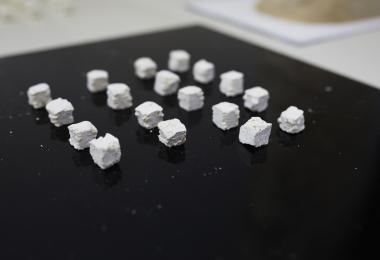
Jameed cubes on display, used as building material for the Ein Ghazal statue by Omar Sartawi.
This edible statue is a replica of the Ein Ghazal statue that was discovered in Jordan, currently exhibited in the Louvre - Abu Dhabi, being one of the most significant and important archaeological objects representative of Jordanian cultural heritage. Reinvented with another purely Jordanian product, jameed, the sculpture acquires new physical properties, namely its strength and its resemblance to stone. The replica sculpture challenges the original meaning and purpose of the statue, and questions the erosion of our cultural heritage, while also experimenting with the idea of using jameed for purposes other than food.
© Amman Design Week 2019
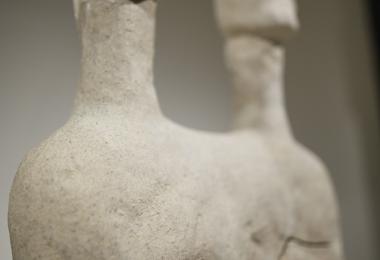
This edible statue is a replica of the Ein Ghazal statue that was discovered in Jordan, currently exhibited in the Louvre - Abu Dhabi, being one of the most significant and important archaeological objects representative of Jordanian cultural heritage. Reinvented with another purely Jordanian product, jameed, the sculpture acquires new physical properties, namely its strength and its resemblance to stone. The replica sculpture challenges the original meaning and purpose of the statue, and questions the erosion of our cultural heritage, while also experimenting with the idea of using jameed for purposes other than food.
© Amman Design Week 2019
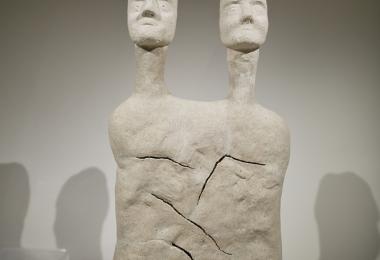
This edible statue is a replica of the Ein Ghazal statue that was discovered in Jordan, currently exhibited in the Louvre - Abu Dhabi, being one of the most significant and important archaeological objects representative of Jordanian cultural heritage. Reinvented with another purely Jordanian product, jameed, the sculpture acquires new physical properties, namely its strength and its resemblance to stone. The replica sculpture challenges the original meaning and purpose of the statue, and questions the erosion of our cultural heritage, while also experimenting with the idea of using jameed for purposes other than food.
© Amman Design Week 2019

These one of a kind handmade wall tapestries are original works of art, woven directly on the loom without the aid of a preliminary design. They are colored with natural vegetable dyes from plants found in the gardens of the Ramses Wissa Wassef Art centre.
This tapestry is woven by Nagla Farouk, age 47, who started weaving when she was 9 years old during school holidays. She depicts the day to day life in the Egyptian village and fields along the banks of the Nile, where farmers with their wives and children are busy working in the fields, attending to their buffalos and animals and harvesting the crops.
“Fields and Countryside” was woven sideways, and took ten months to complete.
© Amman Design Week 2019

This tapestry is woven by Ali Seliem, age 71, who began weaving when he was 8 years old during school holidays. He depicts the daily life in an Egyptian village and fields along the banks of the Nile, where the villagers are going about their activities, attending to their buffalos and animals, with camels carrying the palm reeds. Palms are in full bloom with their red dates.
“Village on the Nile” was woven sideways, and took five months to complete.
© Amman Design Week 2019
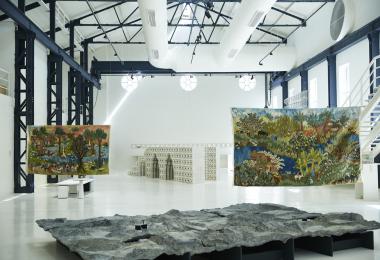
Tapestries by artisans from the Ramses Wissa Wassef Art Center on display at the Hangar Exhibition.
© Amman Design Week 2019
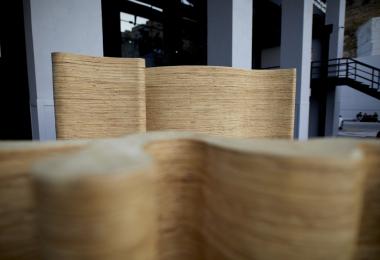
The Canyon Walls are a series of freestanding curvilinear partitions inspired by the Jordanian Siq, or naturally formed canyon. These walls are arranged to create a narrow passage, a sanctuary where people can disconnect and experience moments of spatial expansion and compression.
The wavy shapes of the walls evoke the natural creation of canyons over time; flowing water that softens the sandstone’s hard edges, carving in its wake niches and voids.
Similarly to the accumulation of sandstone layers in the beautiful mountains of Jordan, the Canyon Walls are constructed by compressing multiple thin layers of various woods, culminating in a wide palette of vibrant earthy tones.
Each Canyon Wall is also designed as an independent piece: sculpted interior room partitions, containing carved niches that offer places to sit, pause, and reflect.
© Amman Design Week 2019
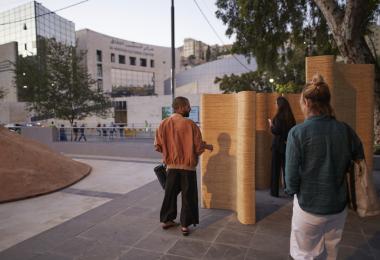
The Canyon Walls are a series of freestanding curvilinear partitions inspired by the Jordanian Siq, or naturally formed canyon. These walls are arranged to create a narrow passage, a sanctuary where people can disconnect and experience moments of spatial expansion and compression.
The wavy shapes of the walls evoke the natural creation of canyons over time; flowing water that softens the sandstone’s hard edges, carving in its wake niches and voids.
Similarly to the accumulation of sandstone layers in the beautiful mountains of Jordan, the Canyon Walls are constructed by compressing multiple thin layers of various woods, culminating in a wide palette of vibrant earthy tones.
Each Canyon Wall is also designed as an independent piece: sculpted interior room partitions, containing carved niches that offer places to sit, pause, and reflect.
© Amman Design Week 2019
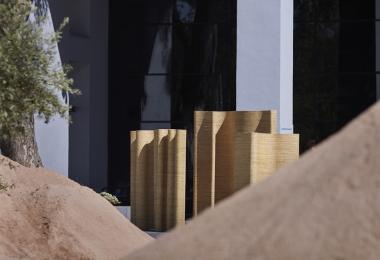
The Canyon Walls are a series of freestanding curvilinear partitions inspired by the Jordanian Siq, or naturally formed canyon. These walls are arranged to create a narrow passage, a sanctuary where people can disconnect and experience moments of spatial expansion and compression.
The wavy shapes of the walls evoke the natural creation of canyons over time; flowing water that softens the sandstone’s hard edges, carving in its wake niches and voids.
Similarly to the accumulation of sandstone layers in the beautiful mountains of Jordan, the Canyon Walls are constructed by compressing multiple thin layers of various woods, culminating in a wide palette of vibrant earthy tones.
Each Canyon Wall is also designed as an independent piece: sculpted interior room partitions, containing carved niches that offer places to sit, pause, and reflect.
© Amman Design Week 2019
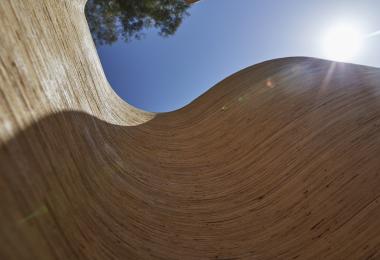
The Canyon Walls are a series of freestanding curvilinear partitions inspired by the Jordanian Siq, or naturally formed canyon. These walls are arranged to create a narrow passage, a sanctuary where people can disconnect and experience moments of spatial expansion and compression.
The wavy shapes of the walls evoke the natural creation of canyons over time; flowing water that softens the sandstone’s hard edges, carving in its wake niches and voids.
Similarly to the accumulation of sandstone layers in the beautiful mountains of Jordan, the Canyon Walls are constructed by compressing multiple thin layers of various woods, culminating in a wide palette of vibrant earthy tones.
Each Canyon Wall is also designed as an independent piece: sculpted interior room partitions, containing carved niches that offer places to sit, pause, and reflect.
© Amman Design Week 2019
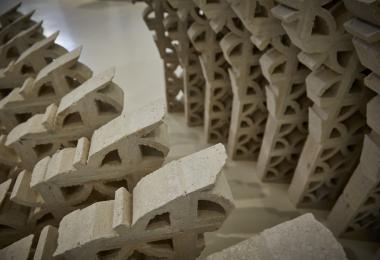
In the 1980s, a new monumentality was being constructed through the signifiers of the "belated" modernity of Amman. This monumentality emphasized a specific national identity using a postmodern language.
This can be read in the symbolic features of the inaugural ‘version’ of the Hashemite Plaza (1986), whether in echoing the Greco-Roman volume, or in the fountain- which was later replaced by a clock tower- that marked the final disappearance of the stream of water, el Seil.
“Saha" is a constellation constructed through the spatial and symbolic definers of the Hashemite Plaza; the Amphitheater, the arcades of Saqf el Seil Street (Quraysh St.), and the invisible body of water.
The body of the plaza itself becomes absent as it dissolves in its surroundings and the competing representations of publics. It is a space that seems to be continually built as a ruin that will soon be reshaped, abandoned or replaced by another in an endless process of building an official image, lingering between the obsolete and restlessness.
© Amman Design Week 2019
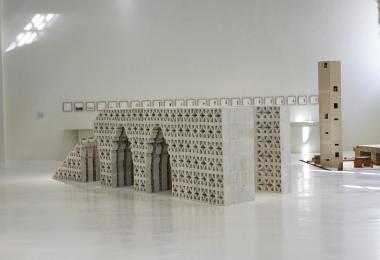
In the 1980s, a new monumentality was being constructed through the signifiers of the "belated" modernity of Amman. This monumentality emphasized a specific national identity using a postmodern language.
This can be read in the symbolic features of the inaugural ‘version’ of the Hashemite Plaza (1986), whether in echoing the Greco-Roman volume, or in the fountain- which was later replaced by a clock tower- that marked the final disappearance of the stream of water, el Seil.
“Saha" is a constellation constructed through the spatial and symbolic definers of the Hashemite Plaza; the Amphitheater, the arcades of Saqf el Seil Street (Quraysh St.), and the invisible body of water.
The body of the plaza itself becomes absent as it dissolves in its surroundings and the competing representations of publics. It is a space that seems to be continually built as a ruin that will soon be reshaped, abandoned or replaced by another in an endless process of building an official image, lingering between the obsolete and restlessness.
© Amman Design Week 2019

In the 1980s, a new monumentality was being constructed through the signifiers of the "belated" modernity of Amman. This monumentality emphasized a specific national identity using a postmodern language.
This can be read in the symbolic features of the inaugural ‘version’ of the Hashemite Plaza (1986), whether in echoing the Greco-Roman volume, or in the fountain- which was later replaced by a clock tower- that marked the final disappearance of the stream of water, el Seil.
“Saha" is a constellation constructed through the spatial and symbolic definers of the Hashemite Plaza; the Amphitheater, the arcades of Saqf el Seil Street (Quraysh St.), and the invisible body of water.
The body of the plaza itself becomes absent as it dissolves in its surroundings and the competing representations of publics. It is a space that seems to be continually built as a ruin that will soon be reshaped, abandoned or replaced by another in an endless process of building an official image, lingering between the obsolete and restlessness.
© Amman Design Week 2019
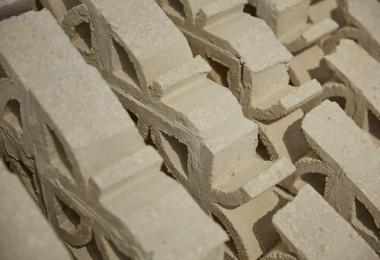
In the 1980s, a new monumentality was being constructed through the signifiers of the "belated" modernity of Amman. This monumentality emphasized a specific national identity using a postmodern language.
This can be read in the symbolic features of the inaugural ‘version’ of the Hashemite Plaza (1986), whether in echoing the Greco-Roman volume, or in the fountain- which was later replaced by a clock tower- that marked the final disappearance of the stream of water, el Seil.
“Saha" is a constellation constructed through the spatial and symbolic definers of the Hashemite Plaza; the Amphitheater, the arcades of Saqf el Seil Street (Quraysh St.), and the invisible body of water.
The body of the plaza itself becomes absent as it dissolves in its surroundings and the competing representations of publics. It is a space that seems to be continually built as a ruin that will soon be reshaped, abandoned or replaced by another in an endless process of building an official image, lingering between the obsolete and restlessness.
© Amman Design Week 2019
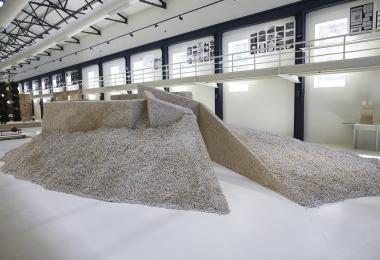
This work explores one of many possibilities that puts together, or joins, separate yet familiar elements in a new body.
Elements:
A mound of gravel
A passageway
A space
A ruin
A landscape
A sculpture
An architecture
The work is a direct reflection of how we perceive and conceive that which surrounds us. It does not attempt to position itself within the confines of a specific use or meaning. It is simply all of the above and yet perhaps none at all. It is an empty form whose significance is what we pour into it and whose memories are what we choose to conjure from it.
© Amman Design Week 2019
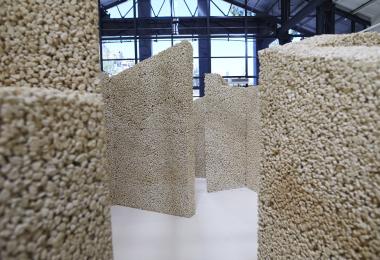
This work explores one of many possibilities that puts together, or joins, separate yet familiar elements in a new body.
Elements:
A mound of gravel
A passageway
A space
A ruin
A landscape
A sculpture
An architecture
The work is a direct reflection of how we perceive and conceive that which surrounds us. It does not attempt to position itself within the confines of a specific use or meaning. It is simply all of the above and yet perhaps none at all. It is an empty form whose significance is what we pour into it and whose memories are what we choose to conjure from it.
© Amman Design Week 2019
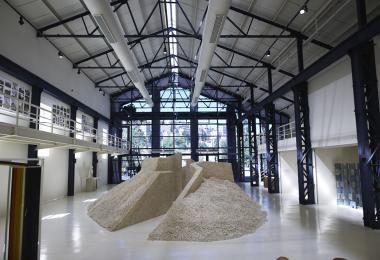
This work explores one of many possibilities that puts together, or joins, separate yet familiar elements in a new body.
Elements:
A mound of gravel
A passageway
A space
A ruin
A landscape
A sculpture
An architecture
The work is a direct reflection of how we perceive and conceive that which surrounds us. It does not attempt to position itself within the confines of a specific use or meaning. It is simply all of the above and yet perhaps none at all. It is an empty form whose significance is what we pour into it and whose memories are what we choose to conjure from it.
© Amman Design Week 2019

This work explores one of many possibilities that puts together, or joins, separate yet familiar elements in a new body.
Elements:
A mound of gravel
A passageway
A space
A ruin
A landscape
A sculpture
An architecture
The work is a direct reflection of how we perceive and conceive that which surrounds us. It does not attempt to position itself within the confines of a specific use or meaning. It is simply all of the above and yet perhaps none at all. It is an empty form whose significance is what we pour into it and whose memories are what we choose to conjure from it.
© Amman Design Week 2019
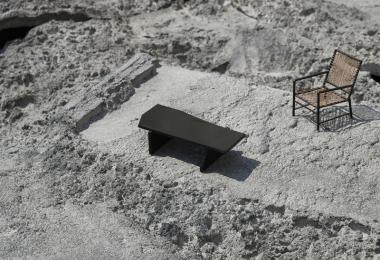
By digging and displacing sand, a man-made topography of planes, pits, and heaps is created revealing different textured surfaces. The resulting installation is a model of cast pigmented gypsum that records and fixates the reliefs within the sand. Represented at a 1:10 scale, the reliefs are imagined as the setting for a possible house, one where within the topography a bedroom, a dining room or a bathroom are nestled between the contours of the land. This constructed and imagined landscape seeks to re-question our often romantic relationship to landscape in architecture by suggesting a more direct and physical relationship to site and land.
© Amman Design Week 2019

By digging and displacing sand, a man-made topography of planes, pits, and heaps is created revealing different textured surfaces. The resulting installation is a model of cast pigmented gypsum that records and fixates the reliefs within the sand. Represented at a 1:10 scale, the reliefs are imagined as the setting for a possible house, one where within the topography a bedroom, a dining room or a bathroom are nestled between the contours of the land. This constructed and imagined landscape seeks to re-question our often romantic relationship to landscape in architecture by suggesting a more direct and physical relationship to site and land.
© Amman Design Week 2019

By digging and displacing sand, a man-made topography of planes, pits, and heaps is created revealing different textured surfaces. The resulting installation is a model of cast pigmented gypsum that records and fixates the reliefs within the sand. Represented at a 1:10 scale, the reliefs are imagined as the setting for a possible house, one where within the topography a bedroom, a dining room or a bathroom are nestled between the contours of the land. This constructed and imagined landscape seeks to re-question our often romantic relationship to landscape in architecture by suggesting a more direct and physical relationship to site and land.
© Amman Design Week 2019
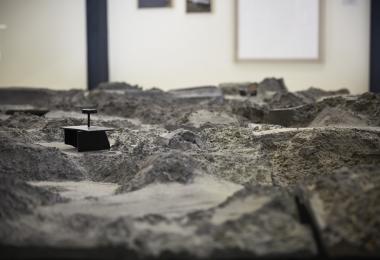
By digging and displacing sand, a man-made topography of planes, pits, and heaps is created revealing different textured surfaces. The resulting installation is a model of cast pigmented gypsum that records and fixates the reliefs within the sand. Represented at a 1:10 scale, the reliefs are imagined as the setting for a possible house, one where within the topography a bedroom, a dining room or a bathroom are nestled between the contours of the land. This constructed and imagined landscape seeks to re-question our often romantic relationship to landscape in architecture by suggesting a more direct and physical relationship to site and land.
© Amman Design Week 2019
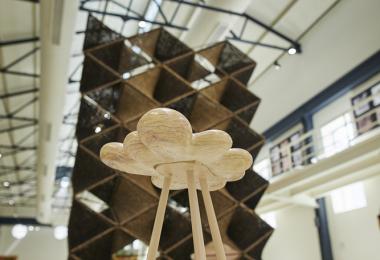
These small sculptures do not carry a specific meaning, and were not created to overwhelm you with their details. They were created because they were originally meant to exist. Sculpted out of pieces of stones found on the land outside the artist’s studio, the shape and size of each found stone dictates, through an intuitive process, the final outcome, whether is a sculpture or a stool.
© Amman Design Week 2019
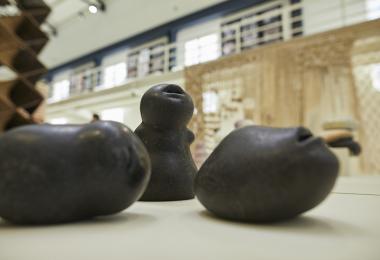
These small sculptures do not carry a specific meaning, and were not created to overwhelm you with their details. They were created because they were originally meant to exist. Sculpted out of pieces of stones found on the land outside the artist’s studio, the shape and size of each found stone dictates, through an intuitive process, the final outcome, whether is a sculpture or a stool.
The image includes 'The Kid', 'The Baby', and 'The Mouth'.
© Amman Design Week 2019
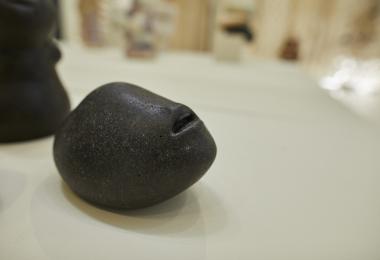
These small sculptures do not carry a specific meaning, and were not created to overwhelm you with their details. They were created because they were originally meant to exist. Sculpted out of pieces of stones found on the land outside the artist’s studio, the shape and size of each found stone dictates, through an intuitive process, the final outcome, whether is a sculpture or a stool.
© Amman Design Week 2019
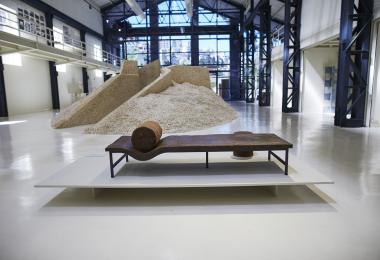
Jordan is a resource-poor country that imports materials from abroad at a high cost to designers and the environment, stunting innovation as unique materials are hard to come by. Made from Jordan is an exploration into utilizing abundant waste streams, turning them into valuable, sustainable and functional everyday products.
This furniture set was developed in house from the materials that were produced to showcase their diverse possibilities and characteristics.
This work was developed as a result of 'Textile Innovation Lab I: Material Innovation,’ a workshop organized by the Amman Design Week and the Goethe-Institut.
© Amman Design Week 2019
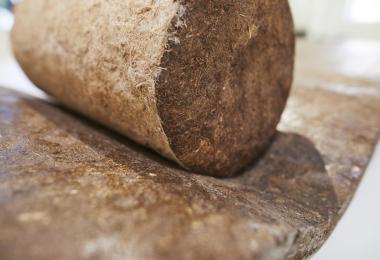
Jordan is a resource-poor country that imports materials from abroad at a high cost to designers and the environment, stunting innovation as unique materials are hard to come by. Made from Jordan is an exploration into utilizing abundant waste streams, turning them into valuable, sustainable and functional everyday products.
This furniture set was developed in house from the materials that were produced to showcase their diverse possibilities and characteristics.
This work was developed as a result of 'Textile Innovation Lab I: Material Innovation,’ a workshop organized by the Amman Design Week and the Goethe-Institut.
© Amman Design Week 2019
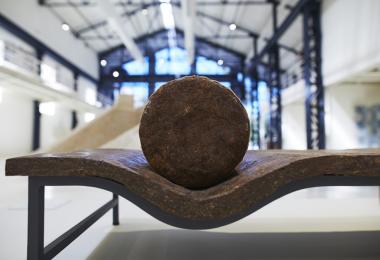
Jordan is a resource-poor country that imports materials from abroad at a high cost to designers and the environment, stunting innovation as unique materials are hard to come by. Made from Jordan is an exploration into utilizing abundant waste streams, turning them into valuable, sustainable and functional everyday products.
This furniture set was developed in house from the materials that were produced to showcase their diverse possibilities and characteristics.
This work was developed as a result of 'Textile Innovation Lab I: Material Innovation,’ a workshop organized by the Amman Design Week and the Goethe-Institut.
© Amman Design Week 2019
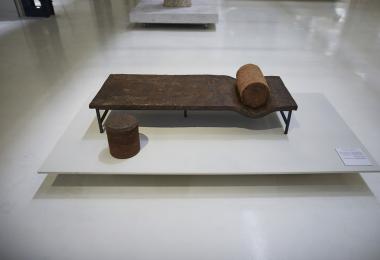
Jordan is a resource-poor country that imports materials from abroad at a high cost to designers and the environment, stunting innovation as unique materials are hard to come by. Made from Jordan is an exploration into utilizing abundant waste streams, turning them into valuable, sustainable and functional everyday products.
This furniture set was developed in house from the materials that were produced to showcase their diverse possibilities and characteristics.
This work was developed as a result of 'Textile Innovation Lab I: Material Innovation,’ a workshop organized by the Amman Design Week and the Goethe-Institut.
© Amman Design Week 2019
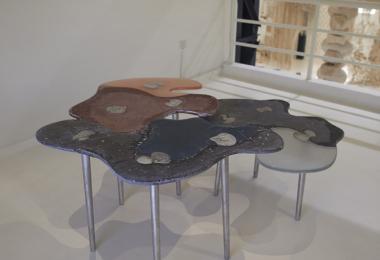
Compounded Tables explores the merger of non-uniform materials and binding resins, revealing a transparency, texture and heaviness that introduces the idea of amalgamation and parasitical absorption within contemporary design.
The tables are produced using precise manufacturing techniques and non-linear casting operations including technological processes in hand-crafting, and the use of recycled industrial materials. Grounded in a whimsical narrative of how materials can eat or corrode one another only to meet halfway, the tables ultimately depict a fusion of fantasy and imagination.
© Amman Design Week 2019
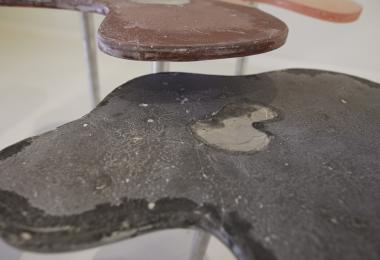
Compounded Tables explores the merger of non-uniform materials and binding resins, revealing a transparency, texture and heaviness that introduces the idea of amalgamation and parasitical absorption within contemporary design.
The tables are produced using precise manufacturing techniques and non-linear casting operations including technological processes in hand-crafting, and the use of recycled industrial materials. Grounded in a whimsical narrative of how materials can eat or corrode one another only to meet halfway, the tables ultimately depict a fusion of fantasy and imagination.
© Amman Design Week 2019
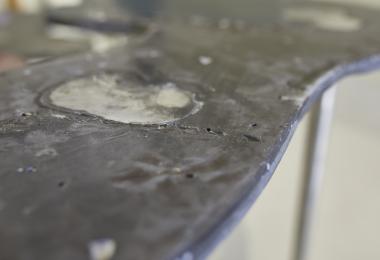
Compounded Tables explores the merger of non-uniform materials and binding resins, revealing a transparency, texture and heaviness that introduces the idea of amalgamation and parasitical absorption within contemporary design.
The tables are produced using precise manufacturing techniques and non-linear casting operations including technological processes in hand-crafting, and the use of recycled industrial materials. Grounded in a whimsical narrative of how materials can eat or corrode one another only to meet halfway, the tables ultimately depict a fusion of fantasy and imagination.
© Amman Design Week 2019

Calm and Chaos is an intimate interactive installation that explores a new form of storytelling using speculative design as a tool for communication.
Inspired by the story of Khaled, a refugee in Germany, the installation is centered around his pillow and the memories it triggered.
Visitors are invited to rest their heads on pillows, and listen to a very personal yet extremely exposed re-reading of Khaled's past, and tap into the unfamiliar - into someone else's intimate space and thoughts.
By juxtaposing the personal and the universal, the choice of medium distorts our perception of pillows, and transforms the feeling of comfort into a foreign, unfamiliar feeling.
© Amman Design Week 2019
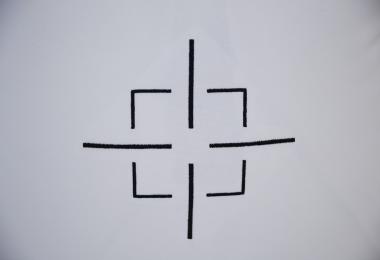
Calm and Chaos is an intimate interactive installation that explores a new form of storytelling using speculative design as a tool for communication.
Inspired by the story of Khaled, a refugee in Germany, the installation is centered around his pillow and the memories it triggered.
Visitors are invited to rest their heads on pillows, and listen to a very personal yet extremely exposed re-reading of Khaled's past, and tap into the unfamiliar - into someone else's intimate space and thoughts.
By juxtaposing the personal and the universal, the choice of medium distorts our perception of pillows, and transforms the feeling of comfort into a foreign, unfamiliar feeling.
© Amman Design Week 2019
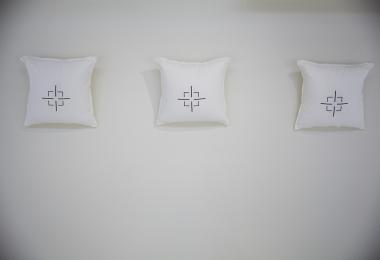
Calm and Chaos is an intimate interactive installation that explores a new form of storytelling using speculative design as a tool for communication.
Inspired by the story of Khaled, a refugee in Germany, the installation is centered around his pillow and the memories it triggered.
Visitors are invited to rest their heads on pillows, and listen to a very personal yet extremely exposed re-reading of Khaled's past, and tap into the unfamiliar - into someone else's intimate space and thoughts.
By juxtaposing the personal and the universal, the choice of medium distorts our perception of pillows, and transforms the feeling of comfort into a foreign, unfamiliar feeling.
© Amman Design Week 2019